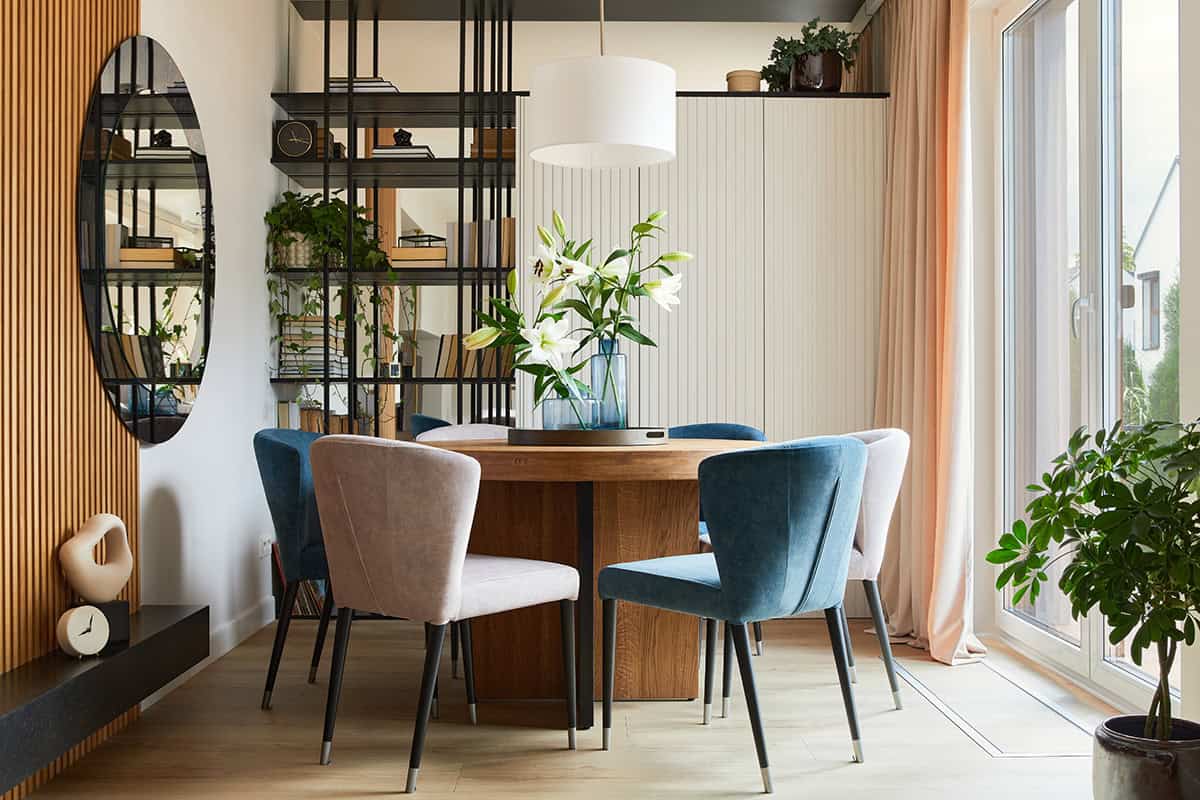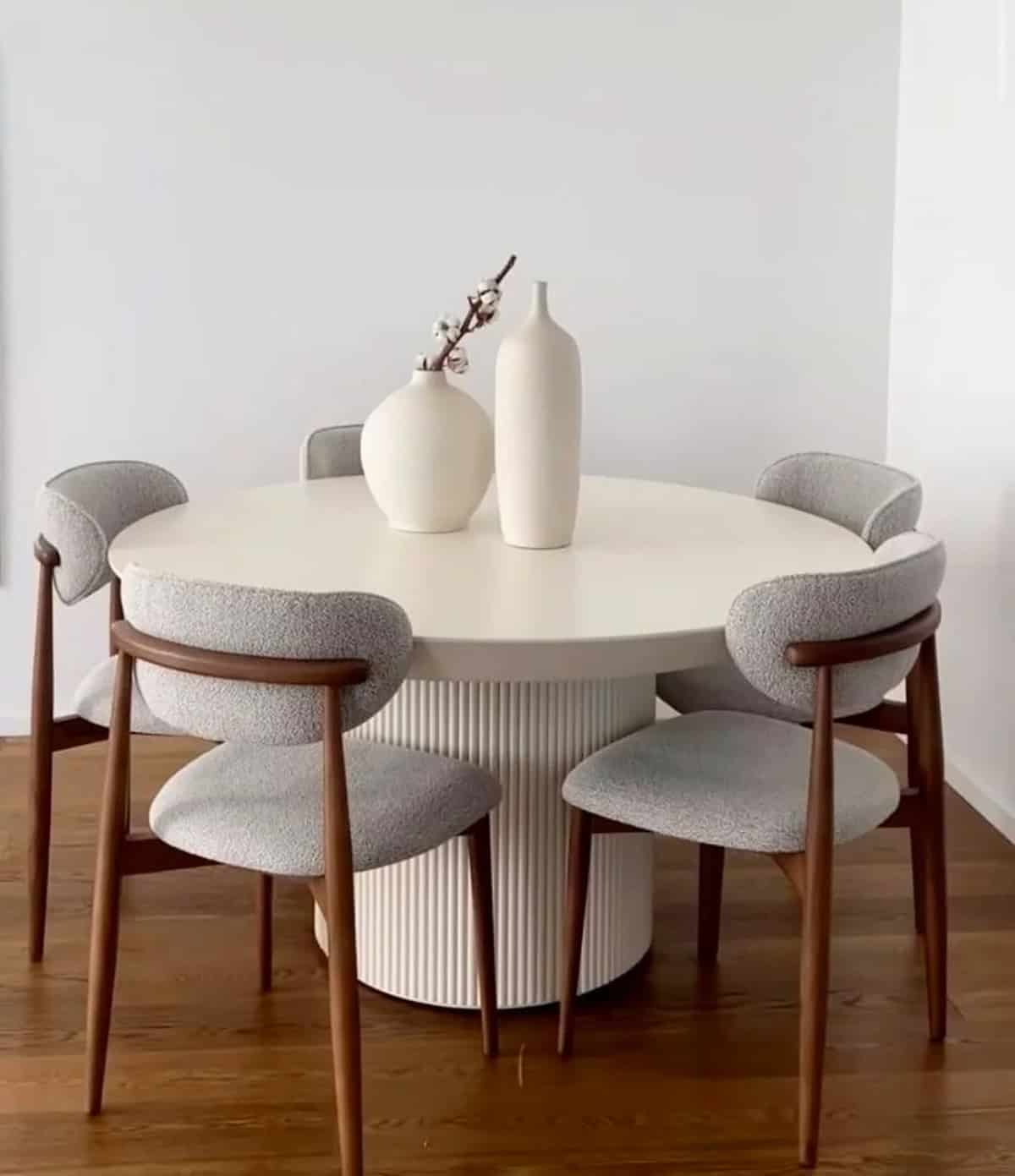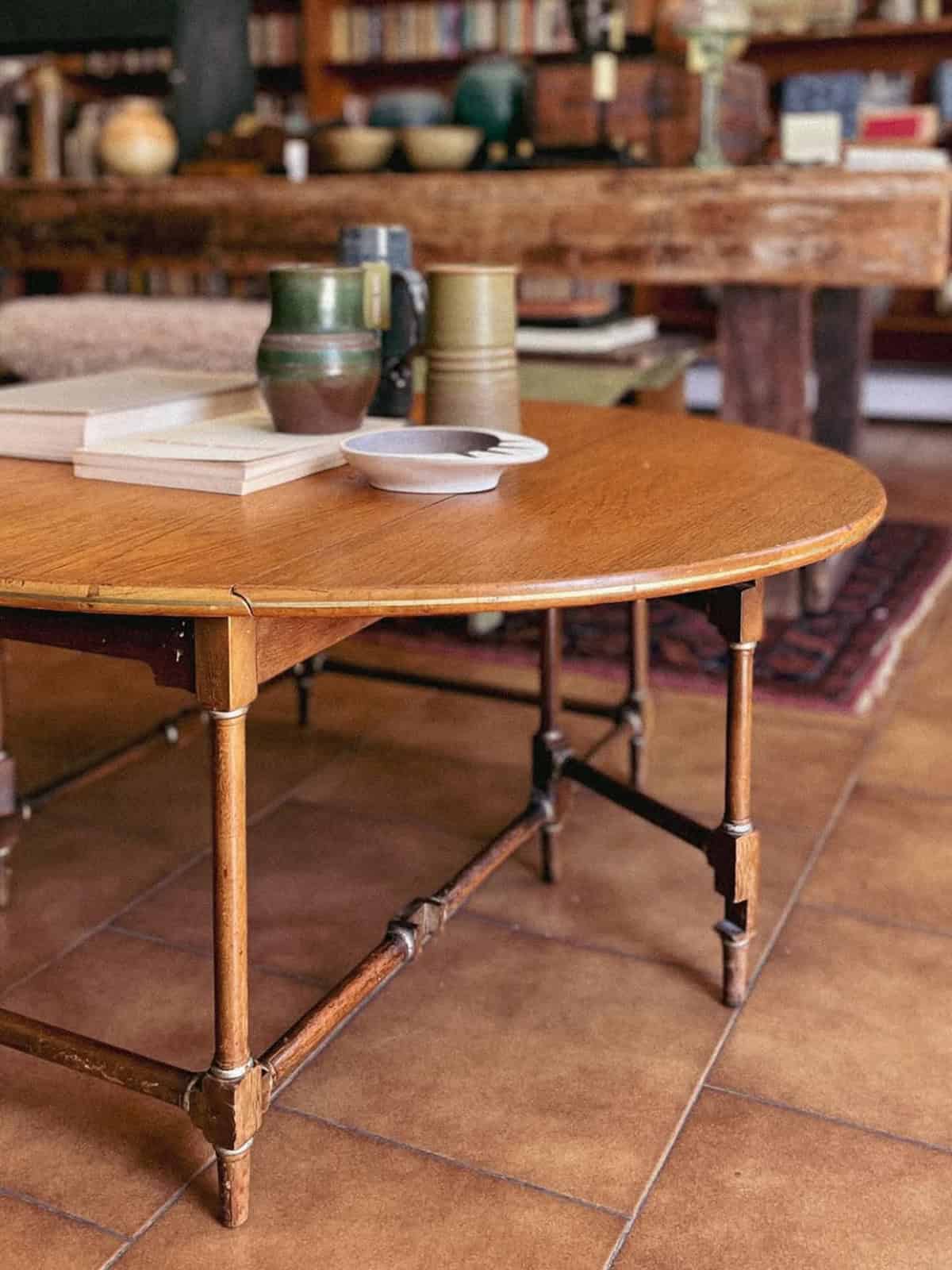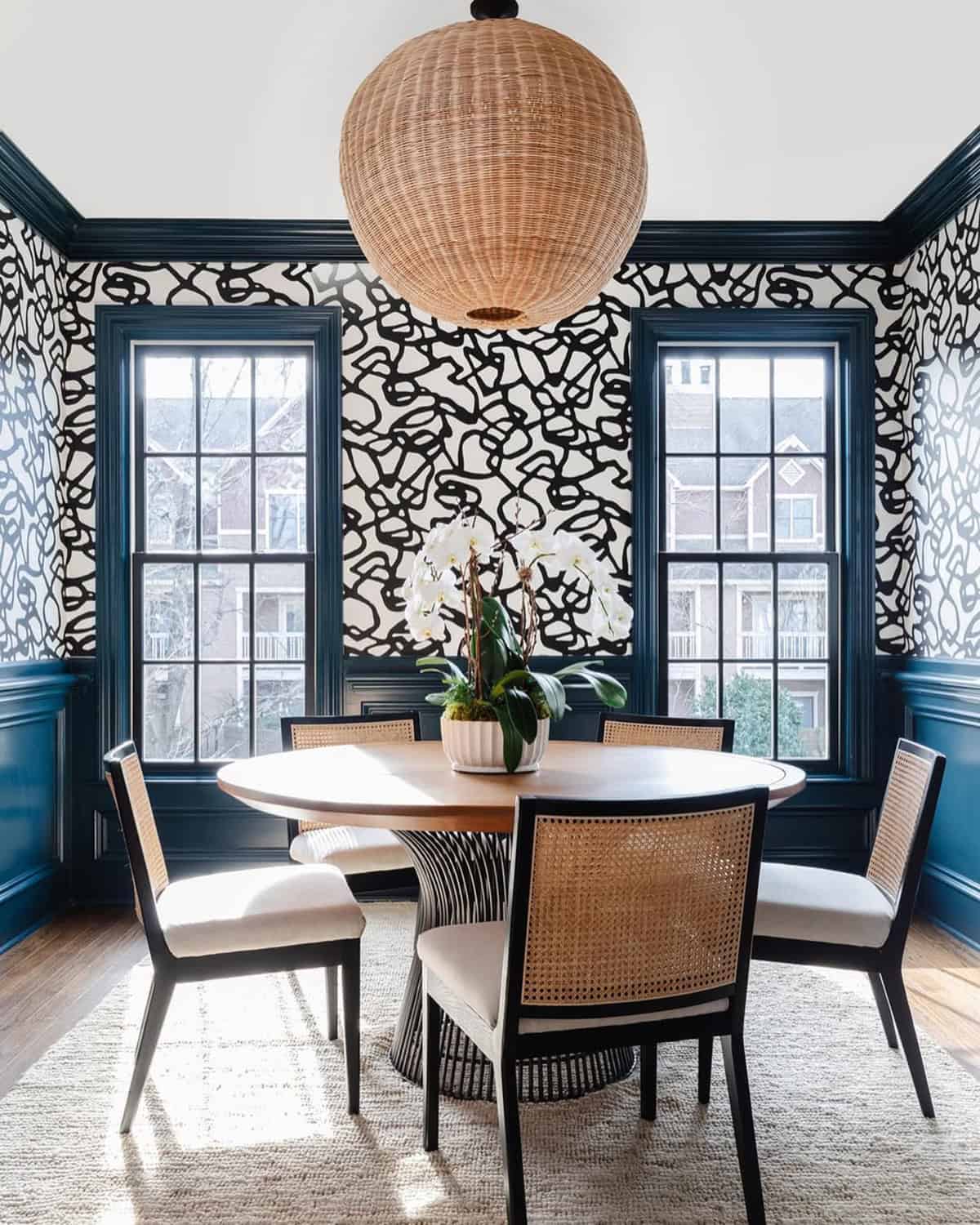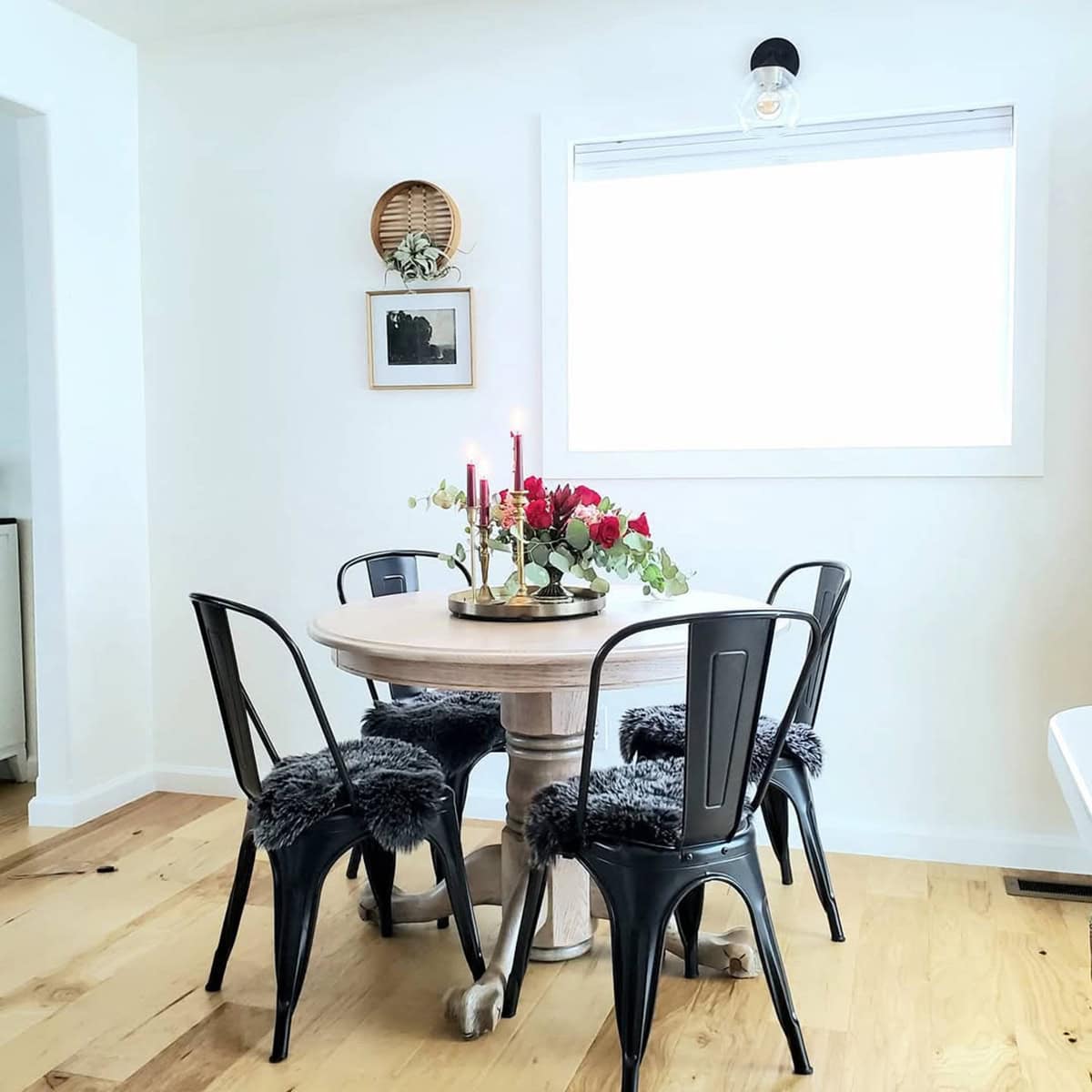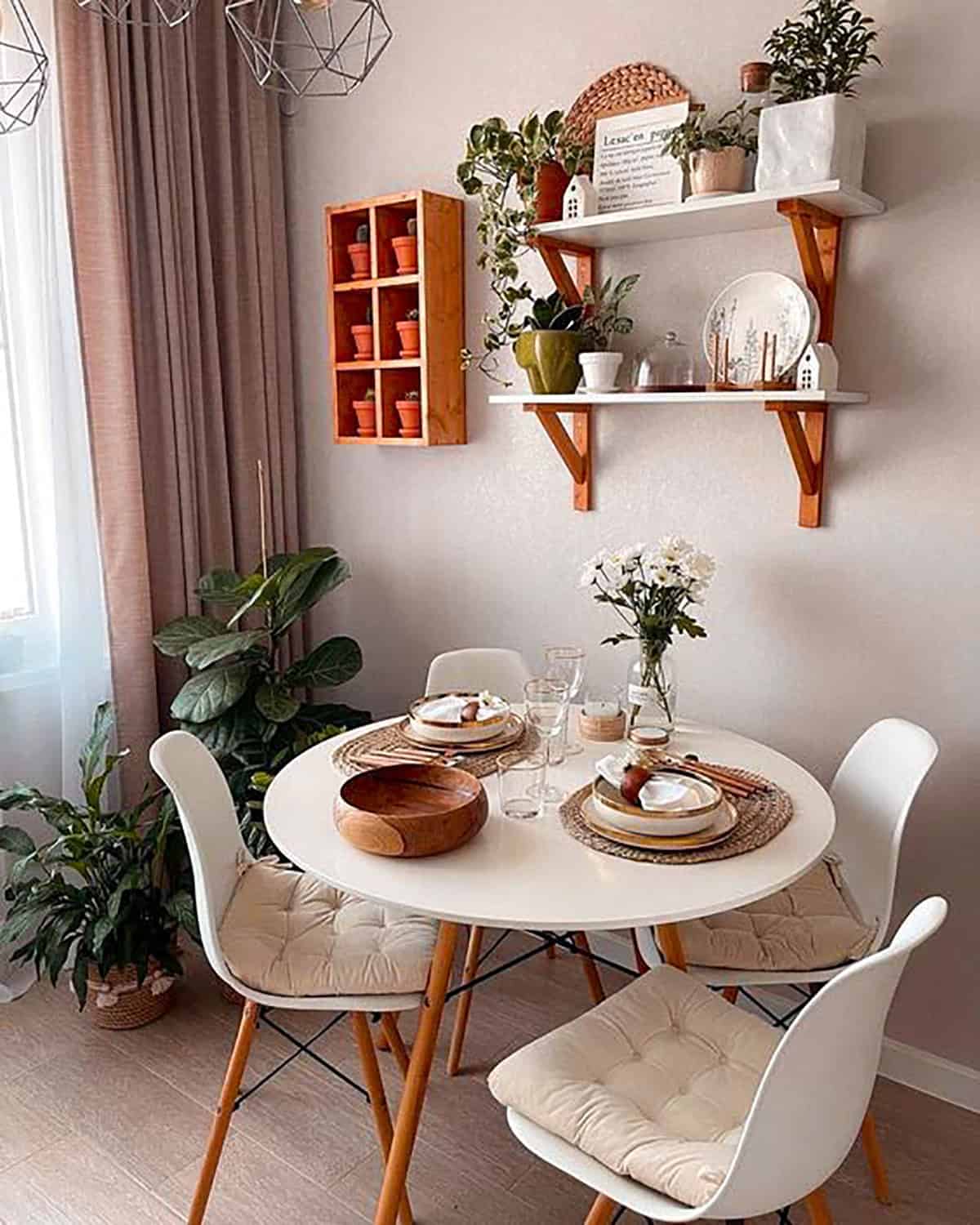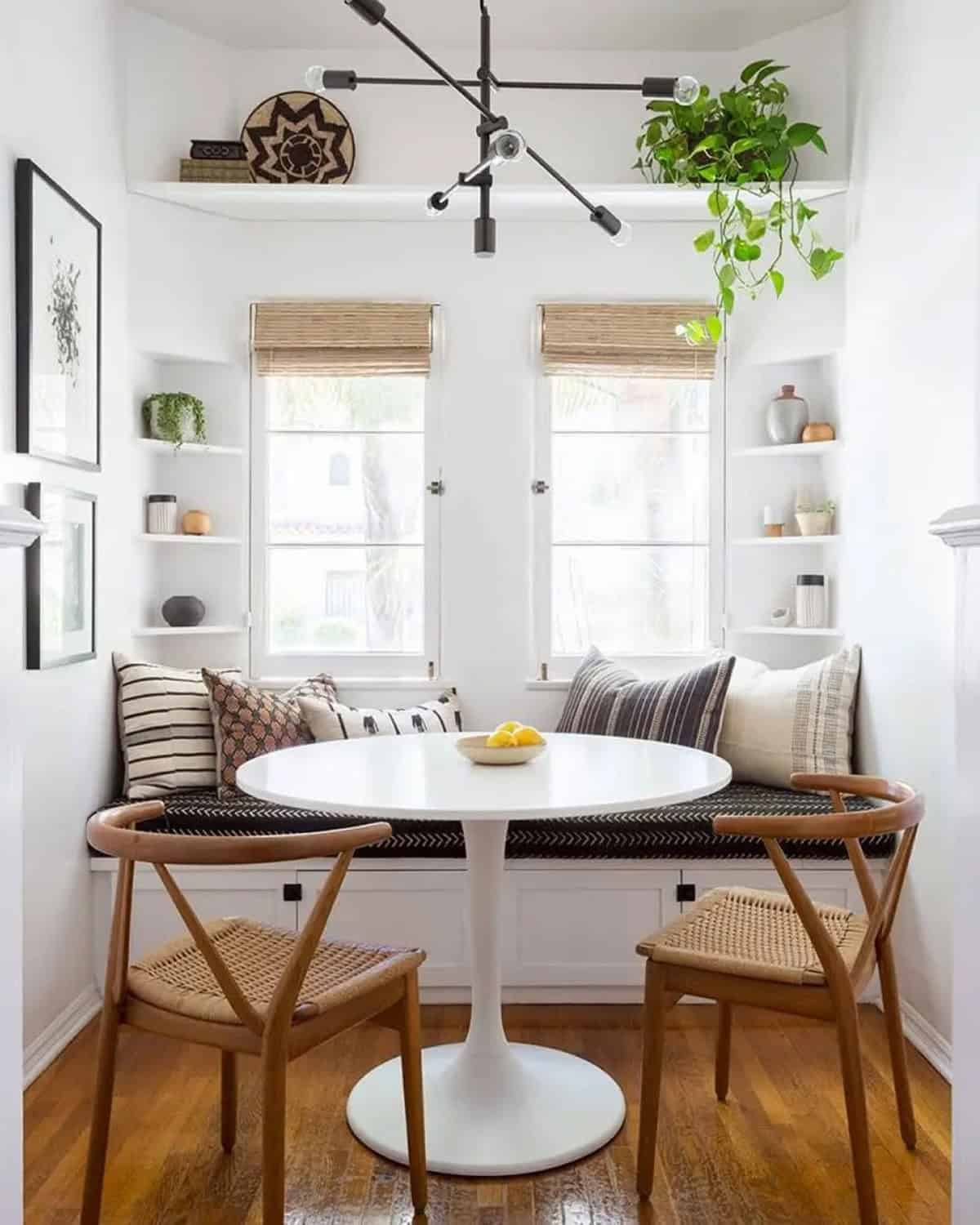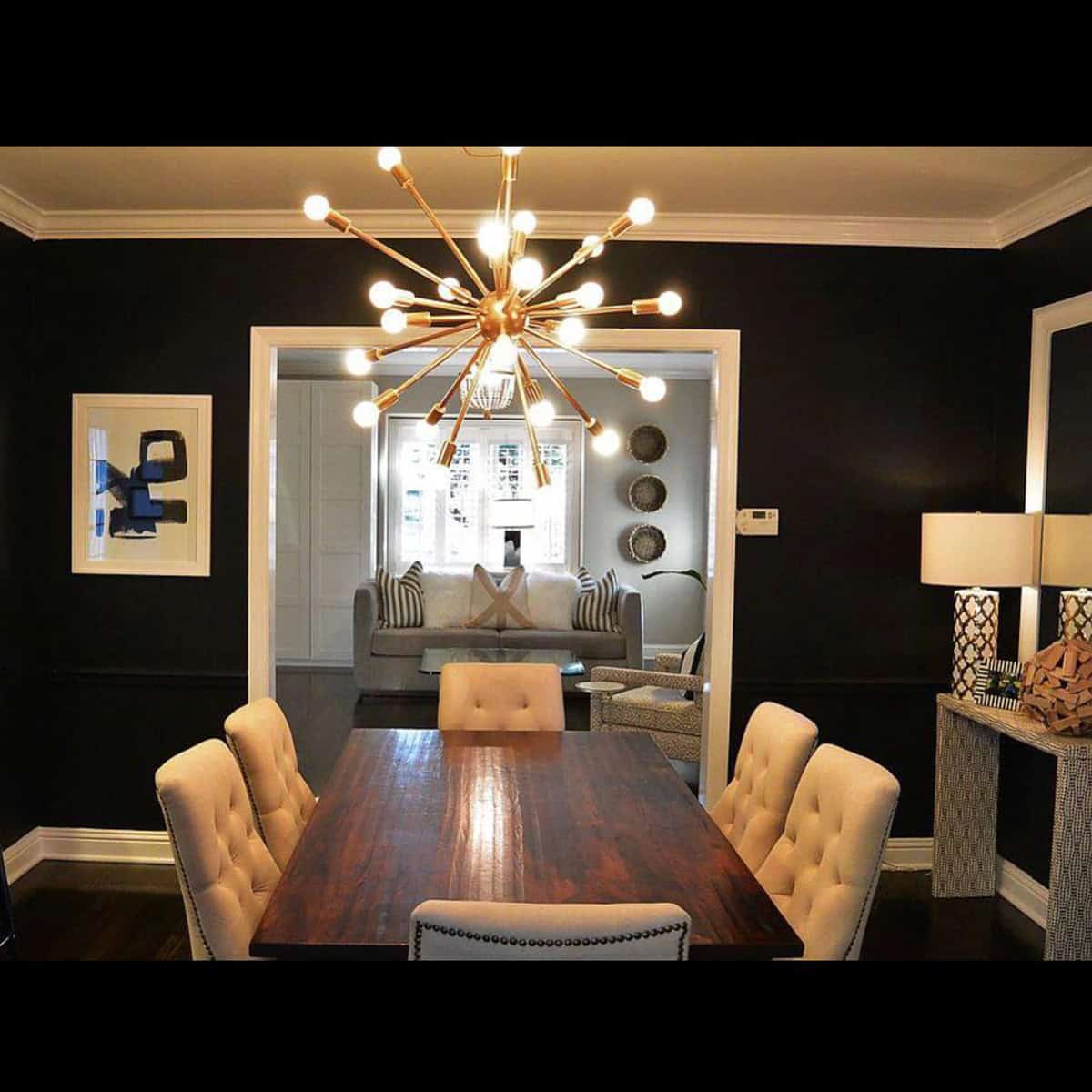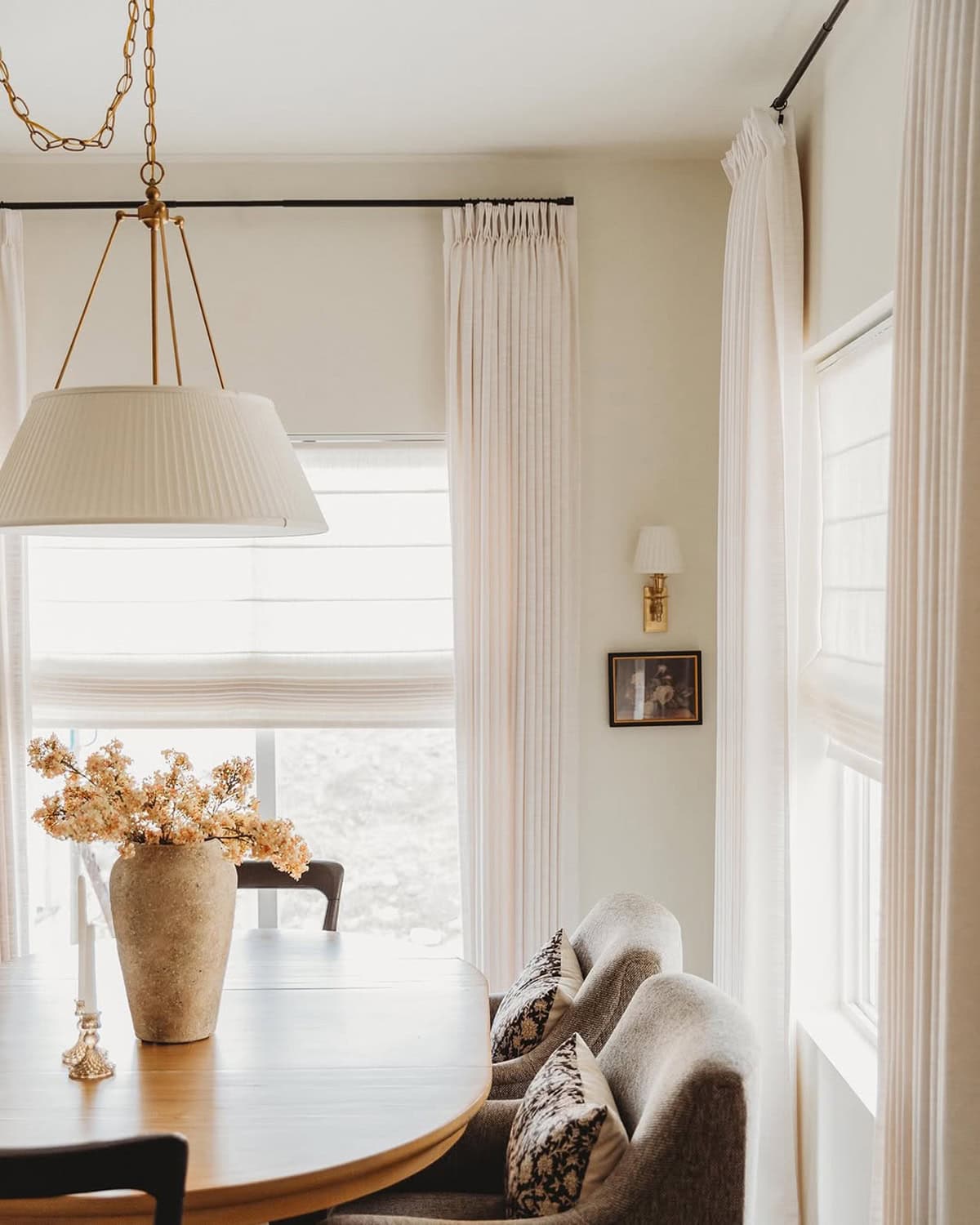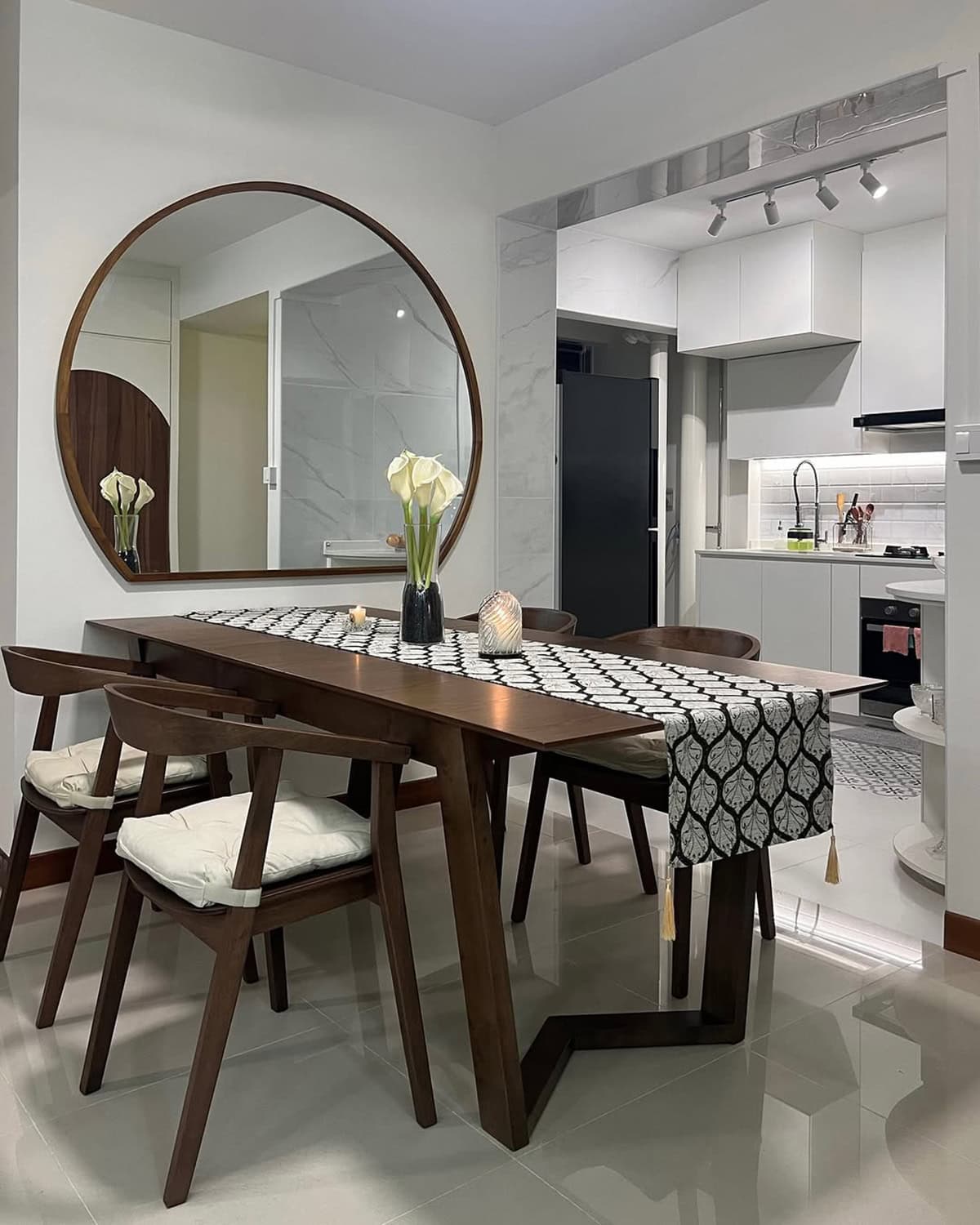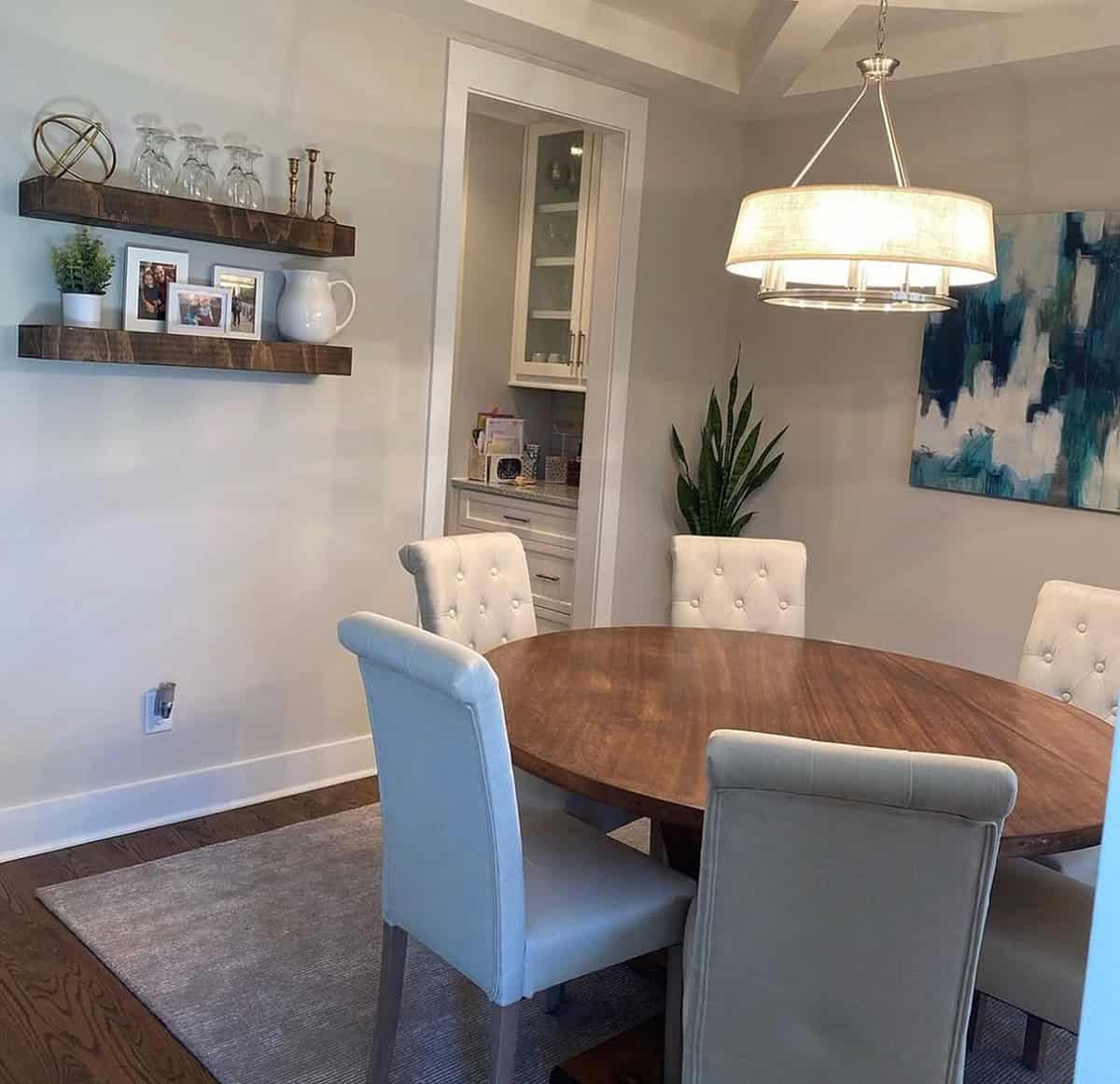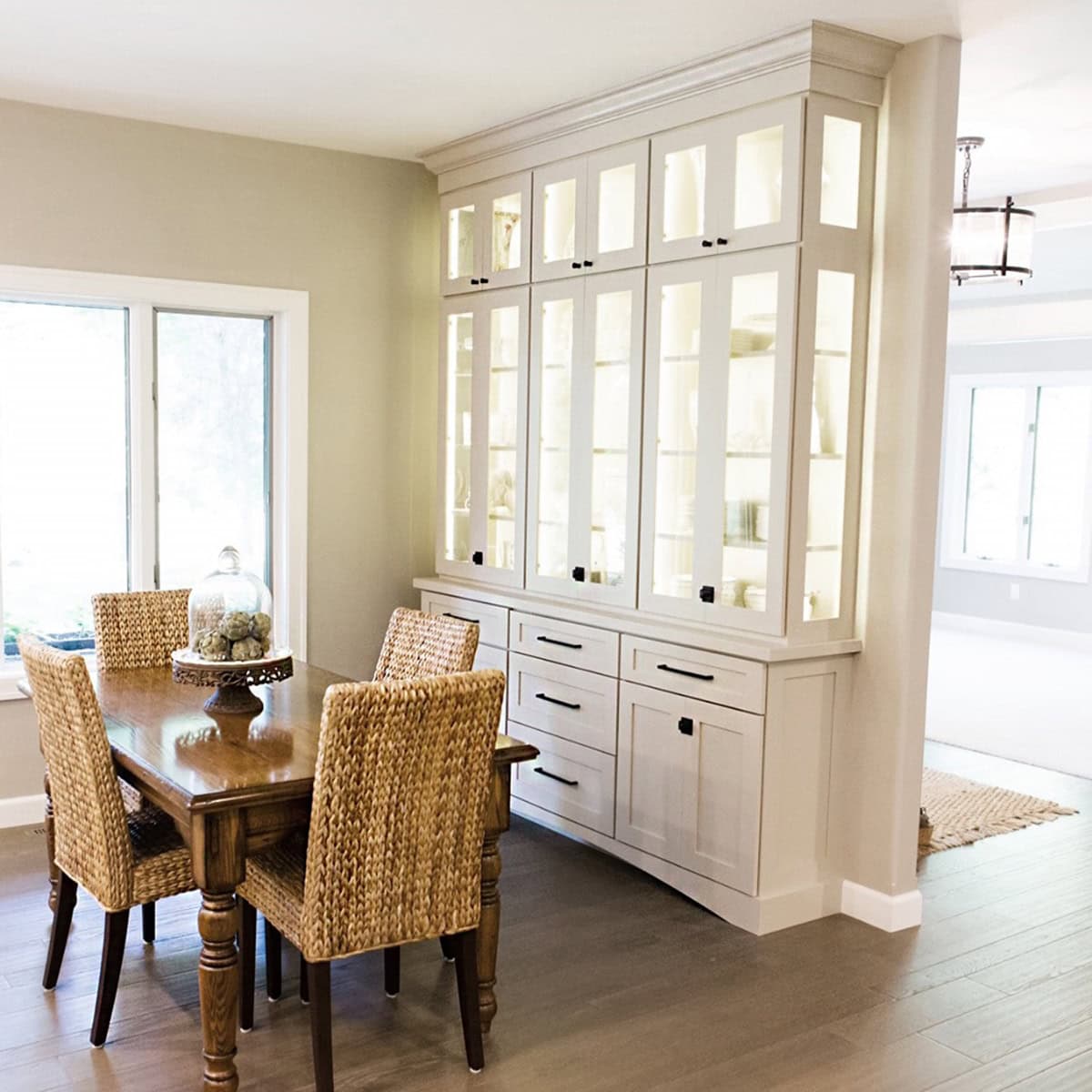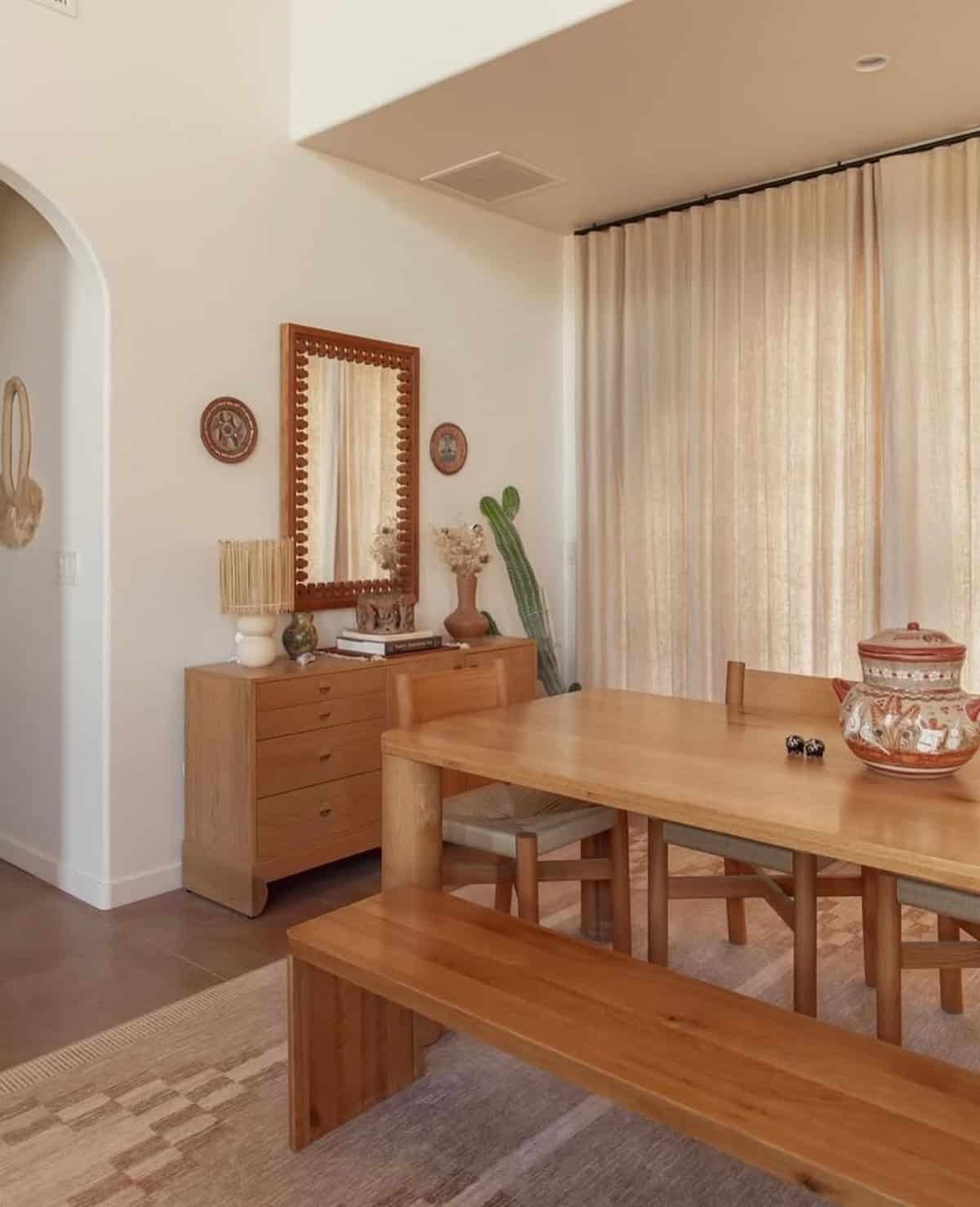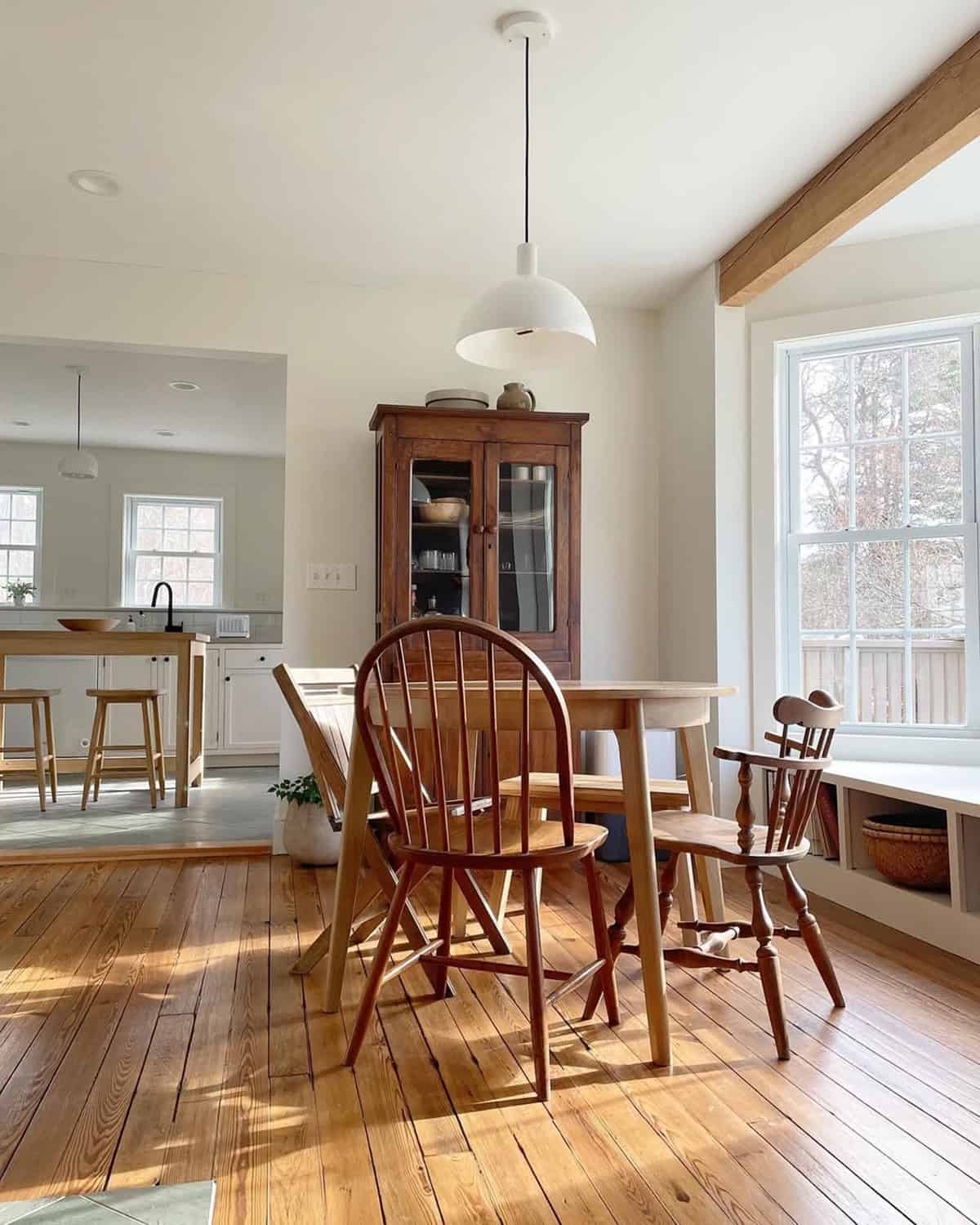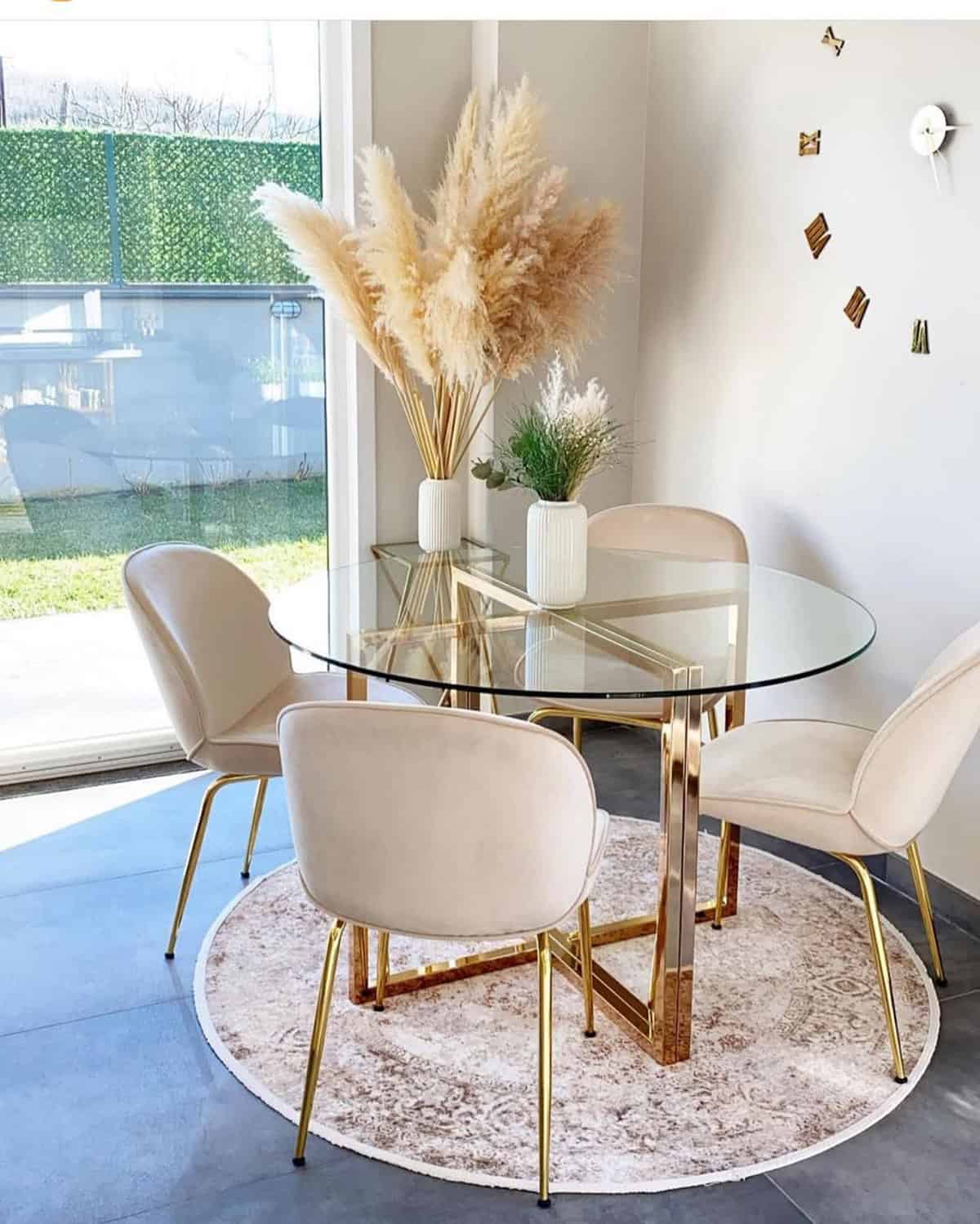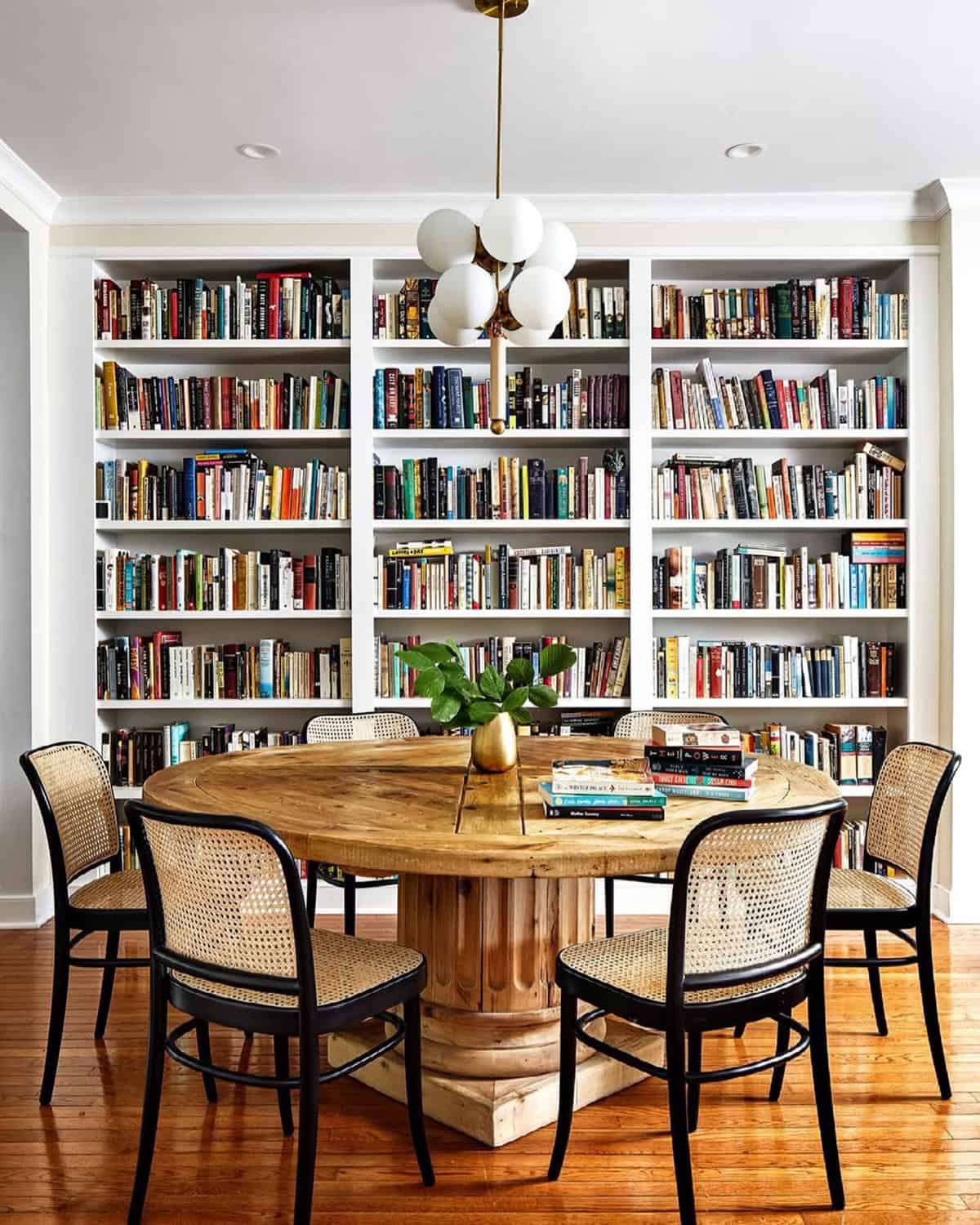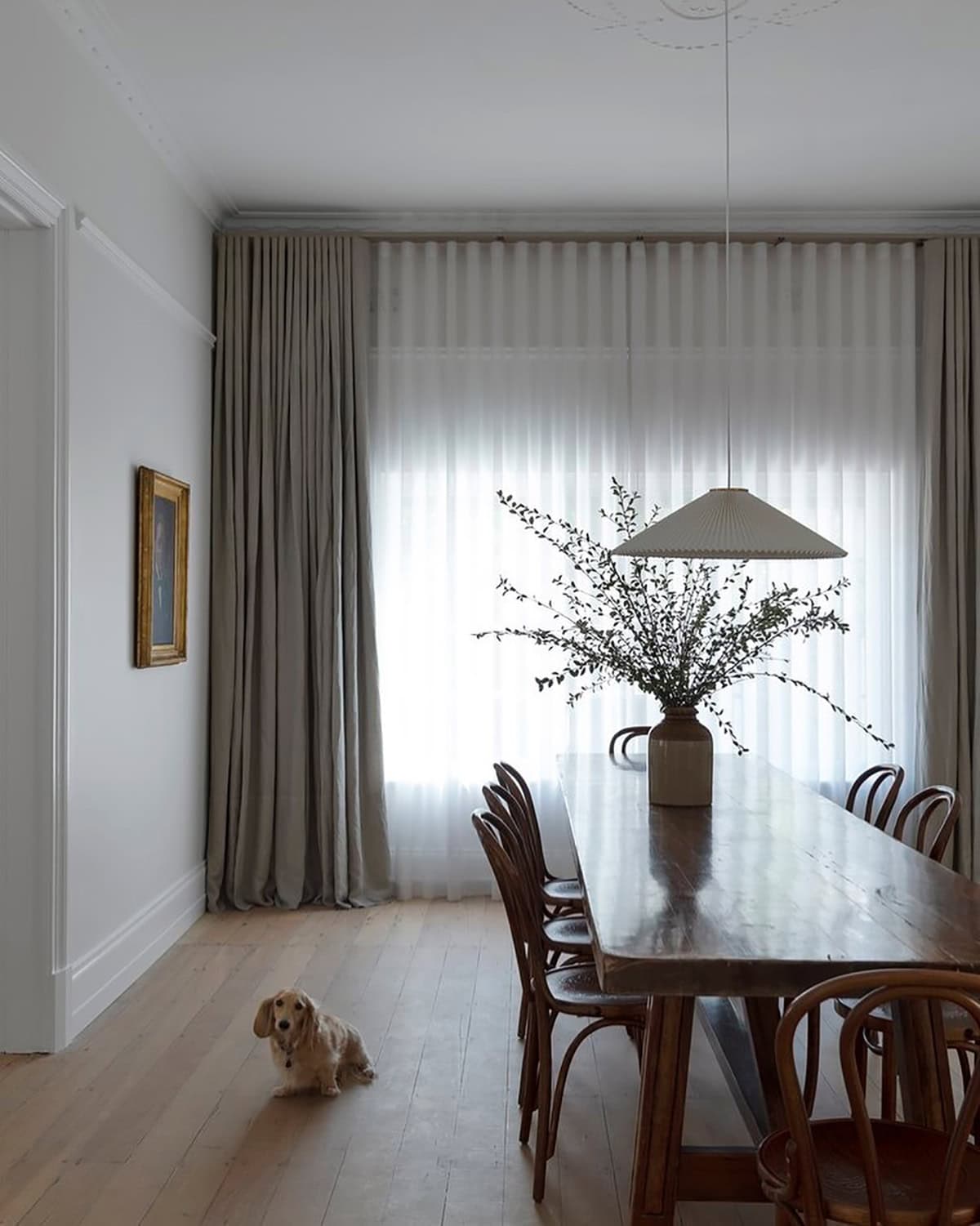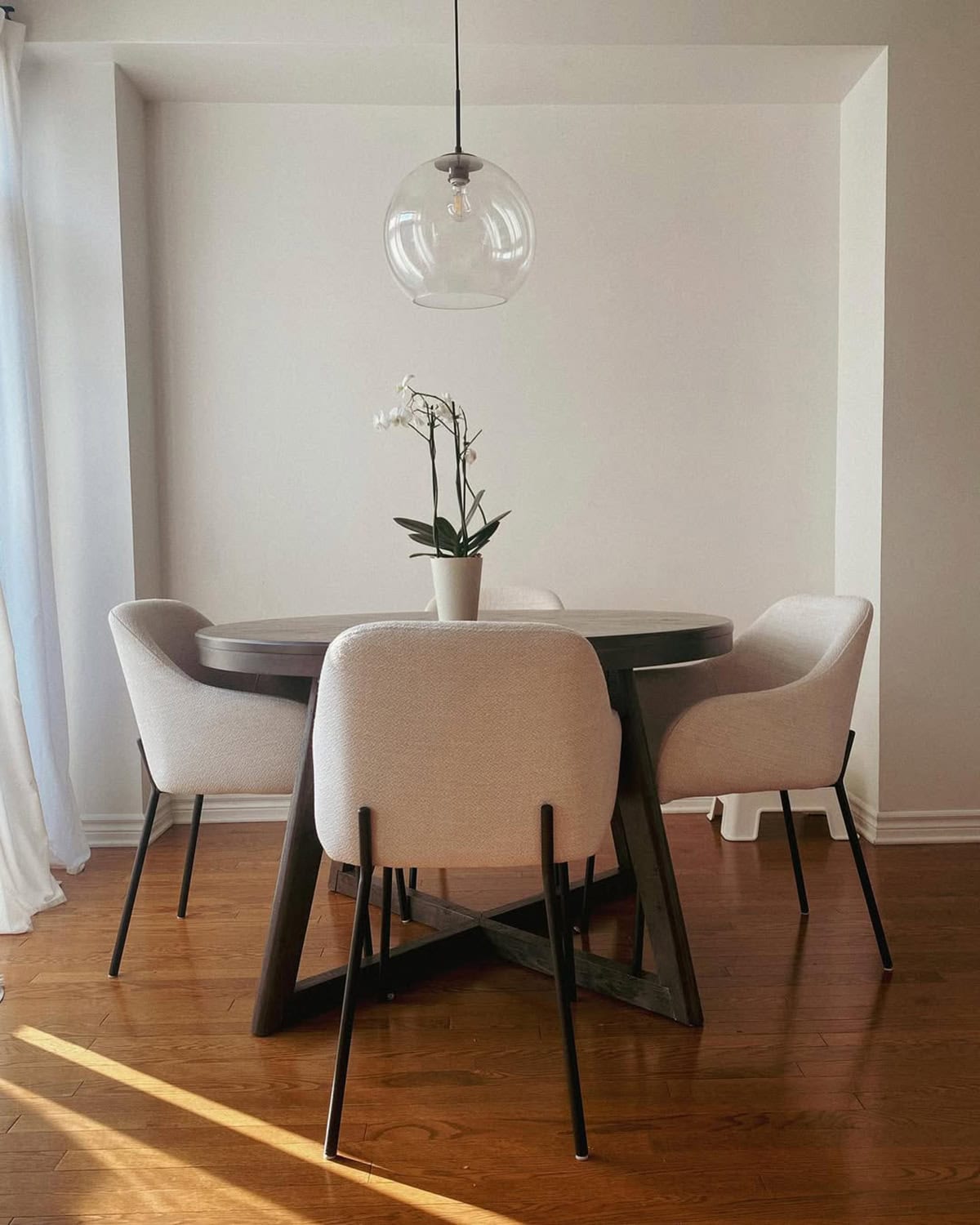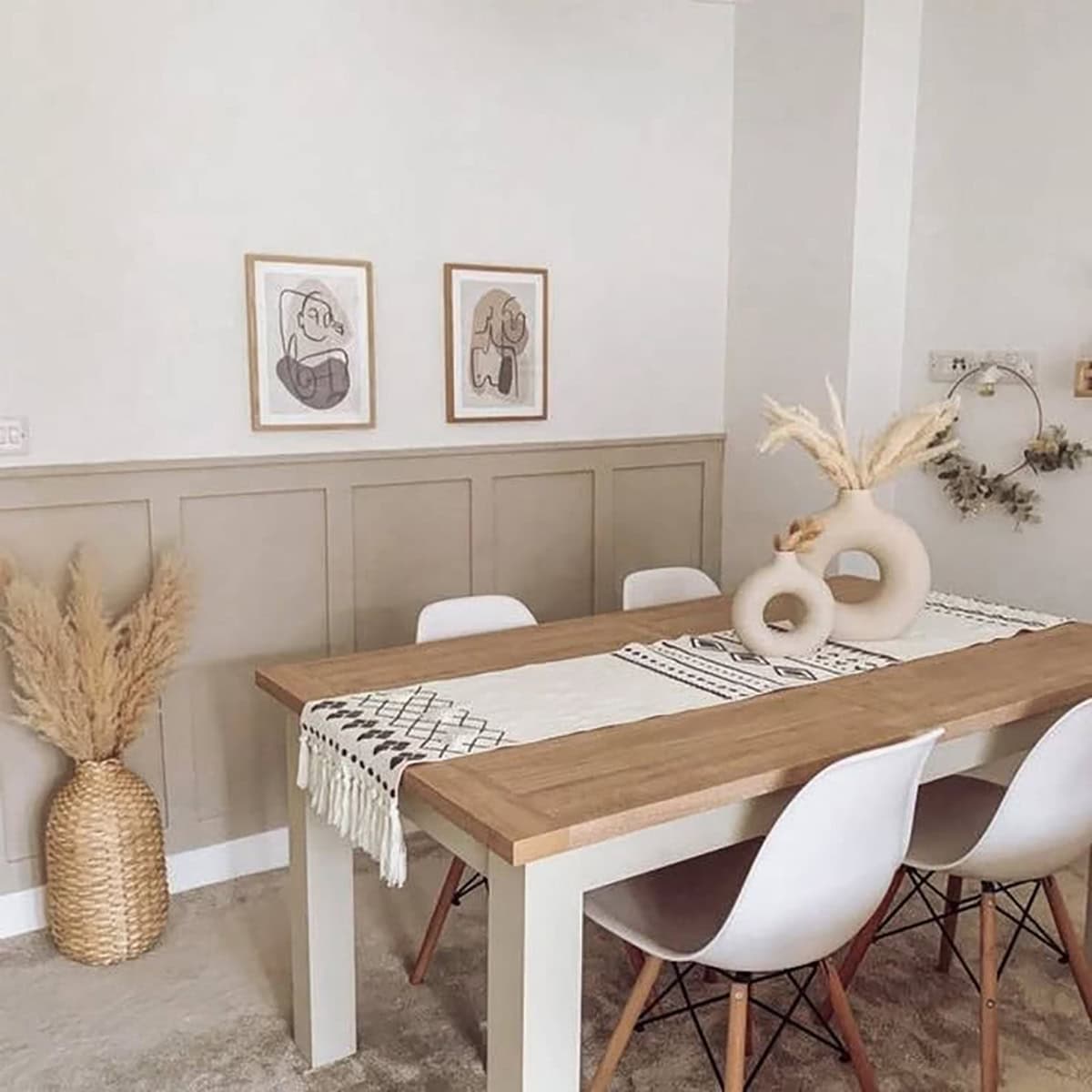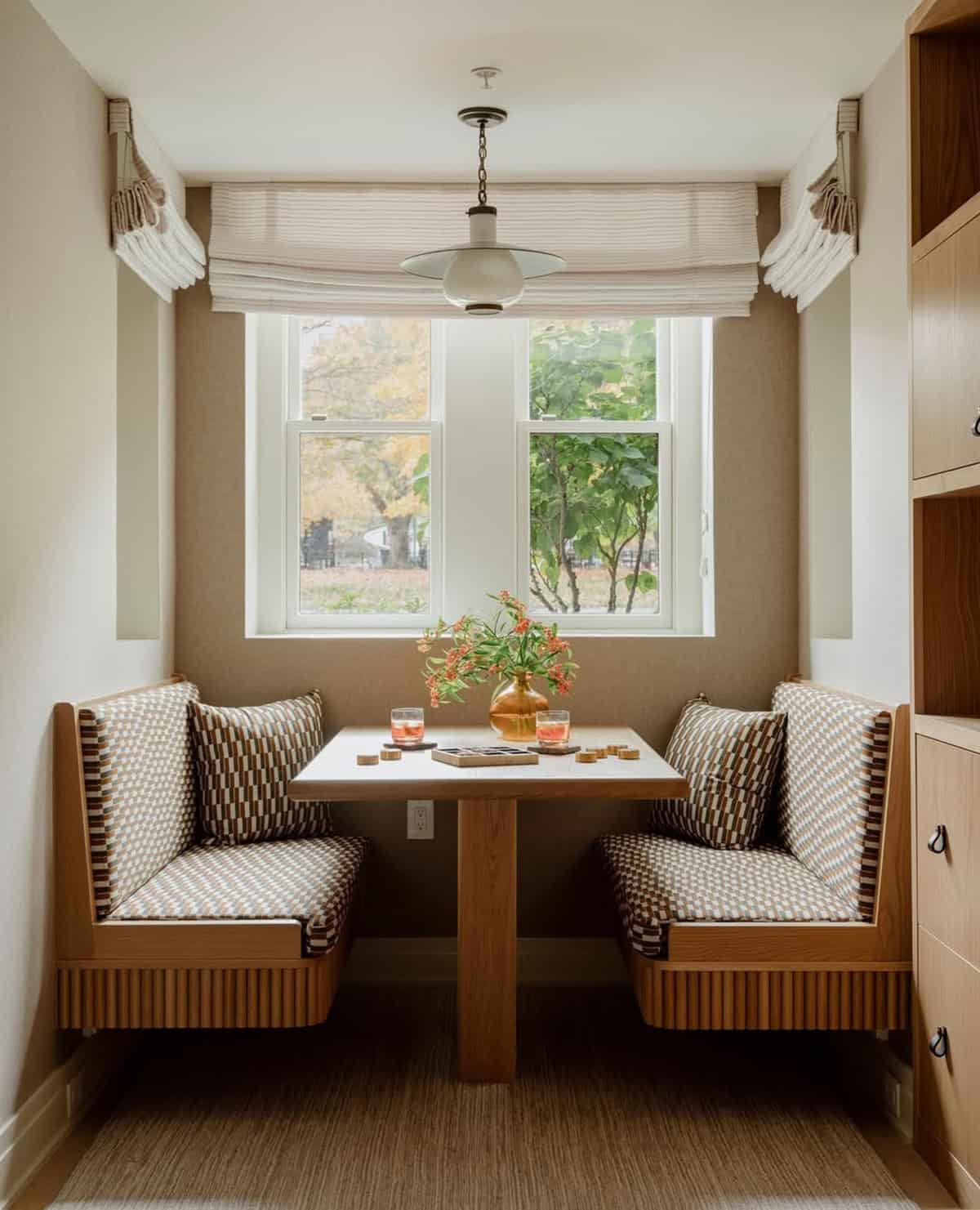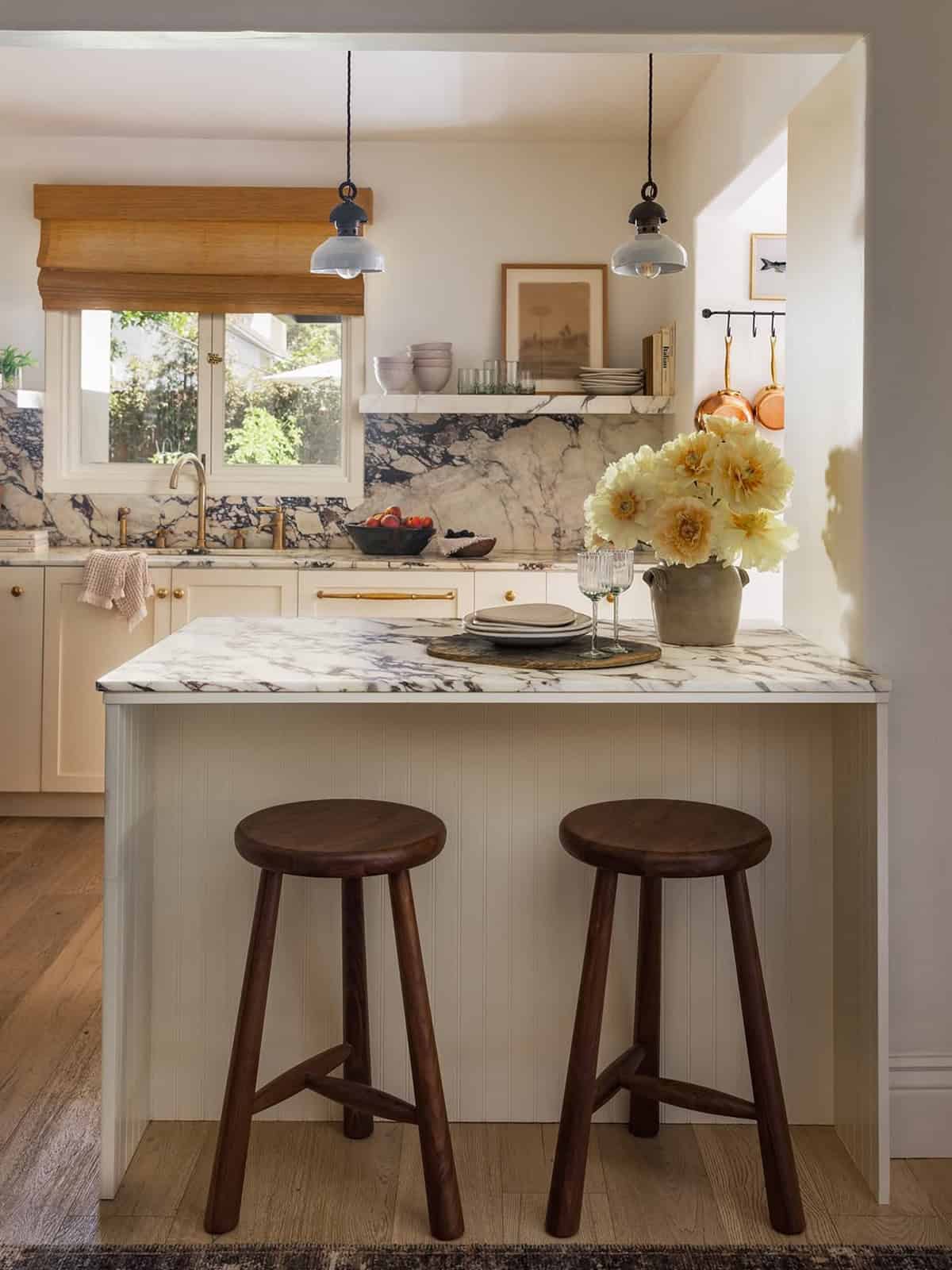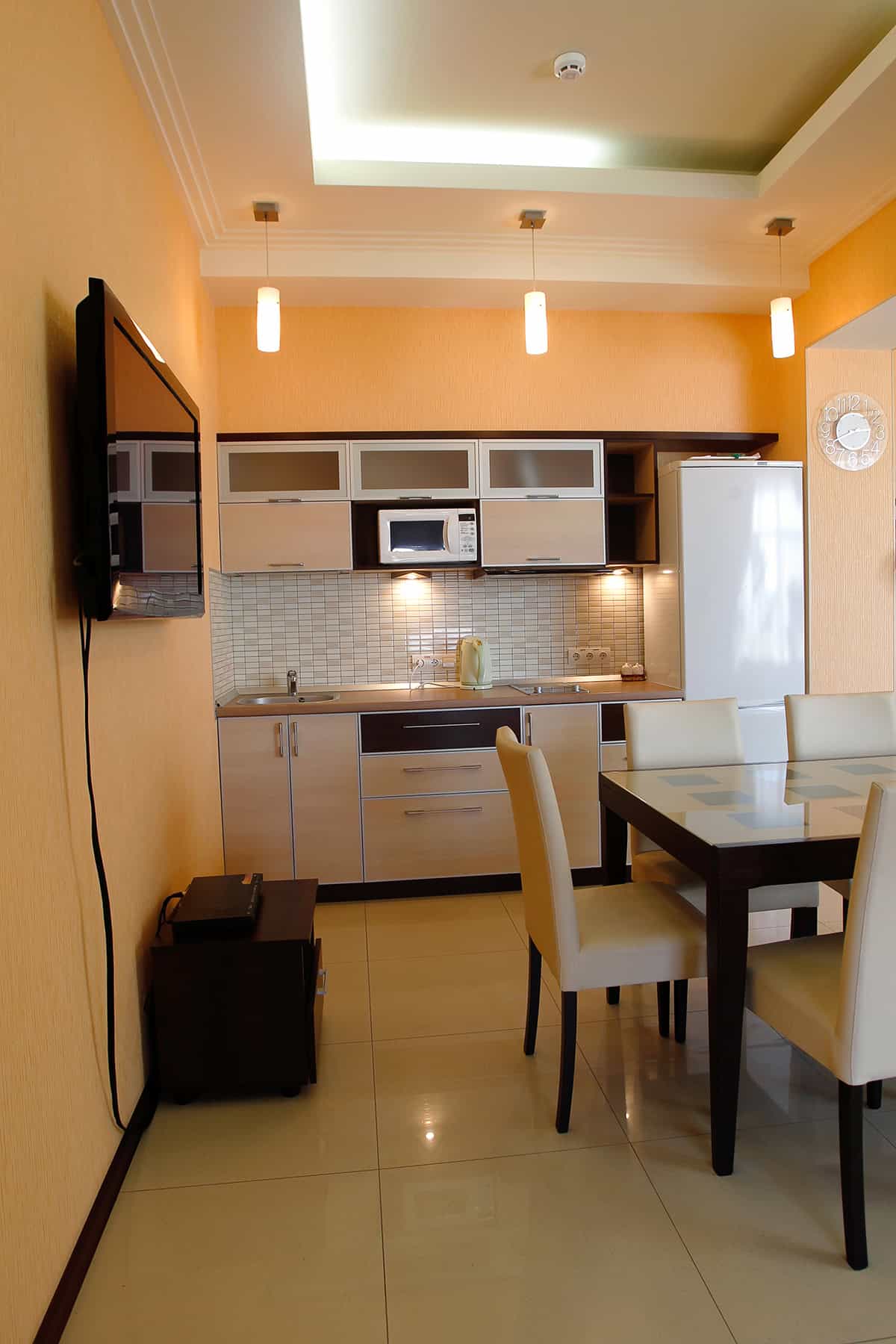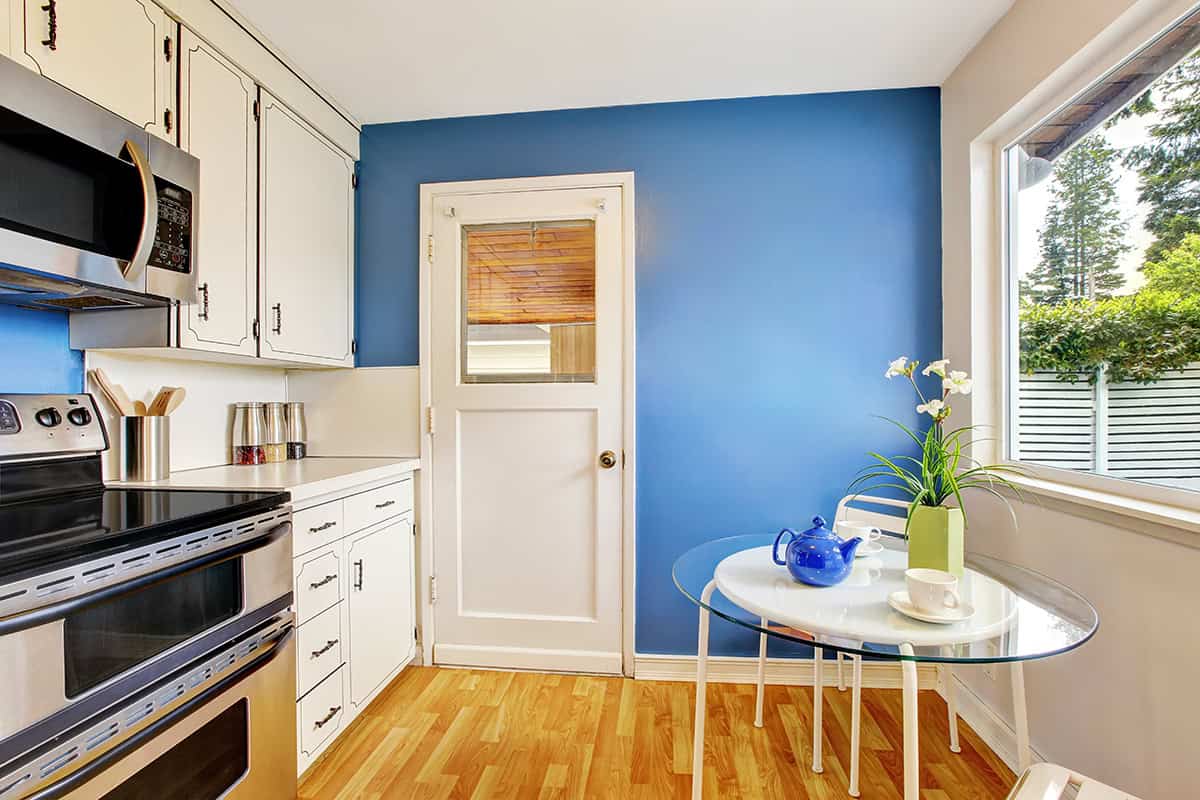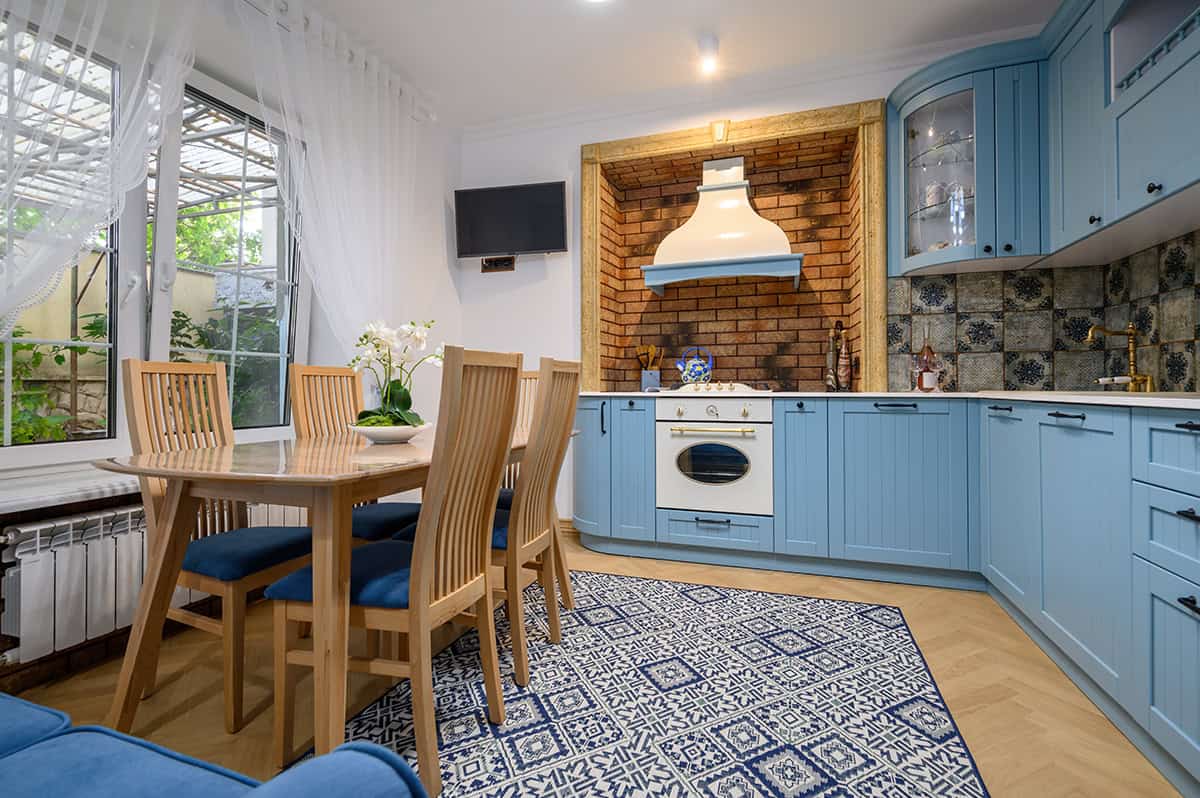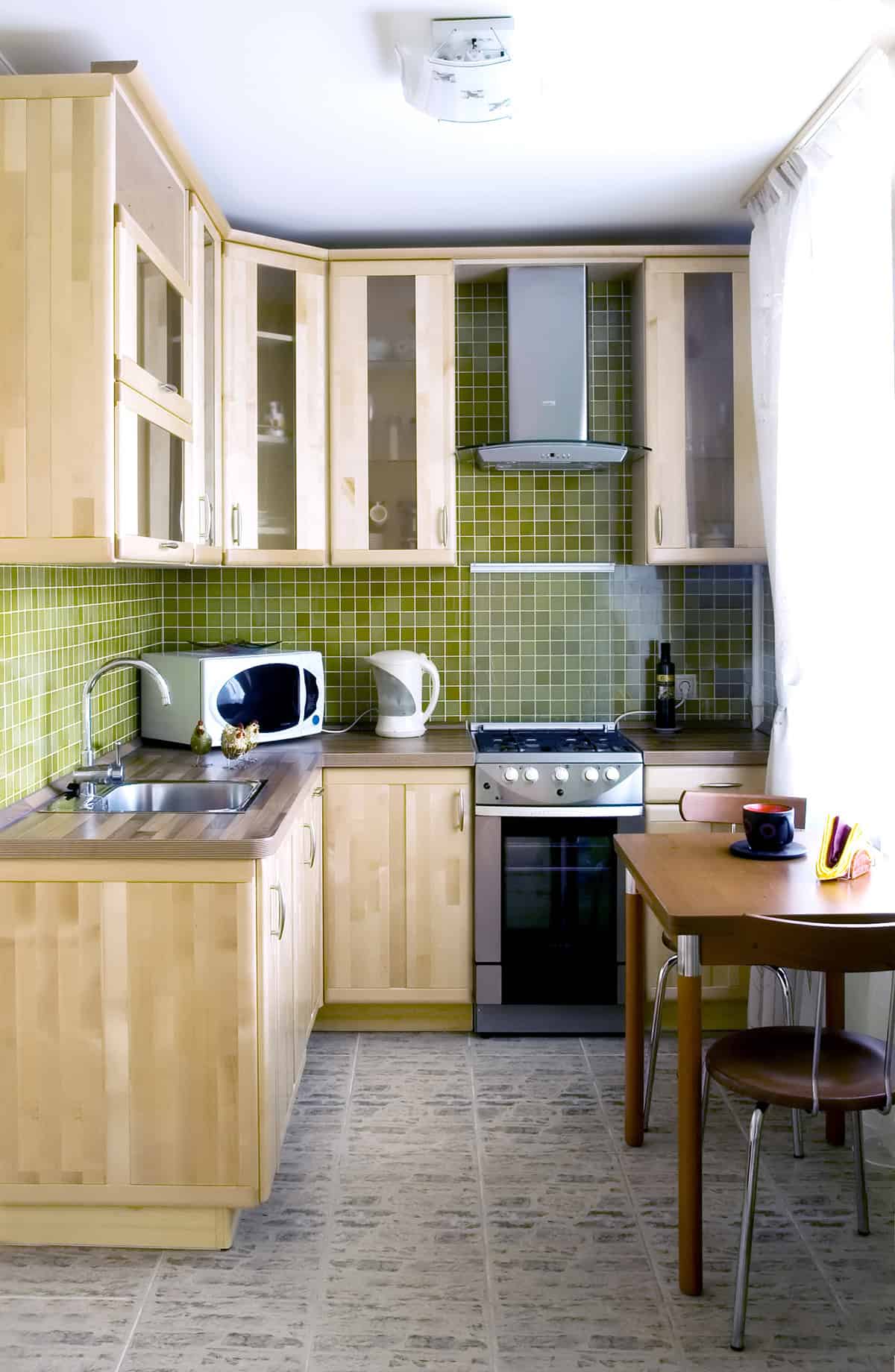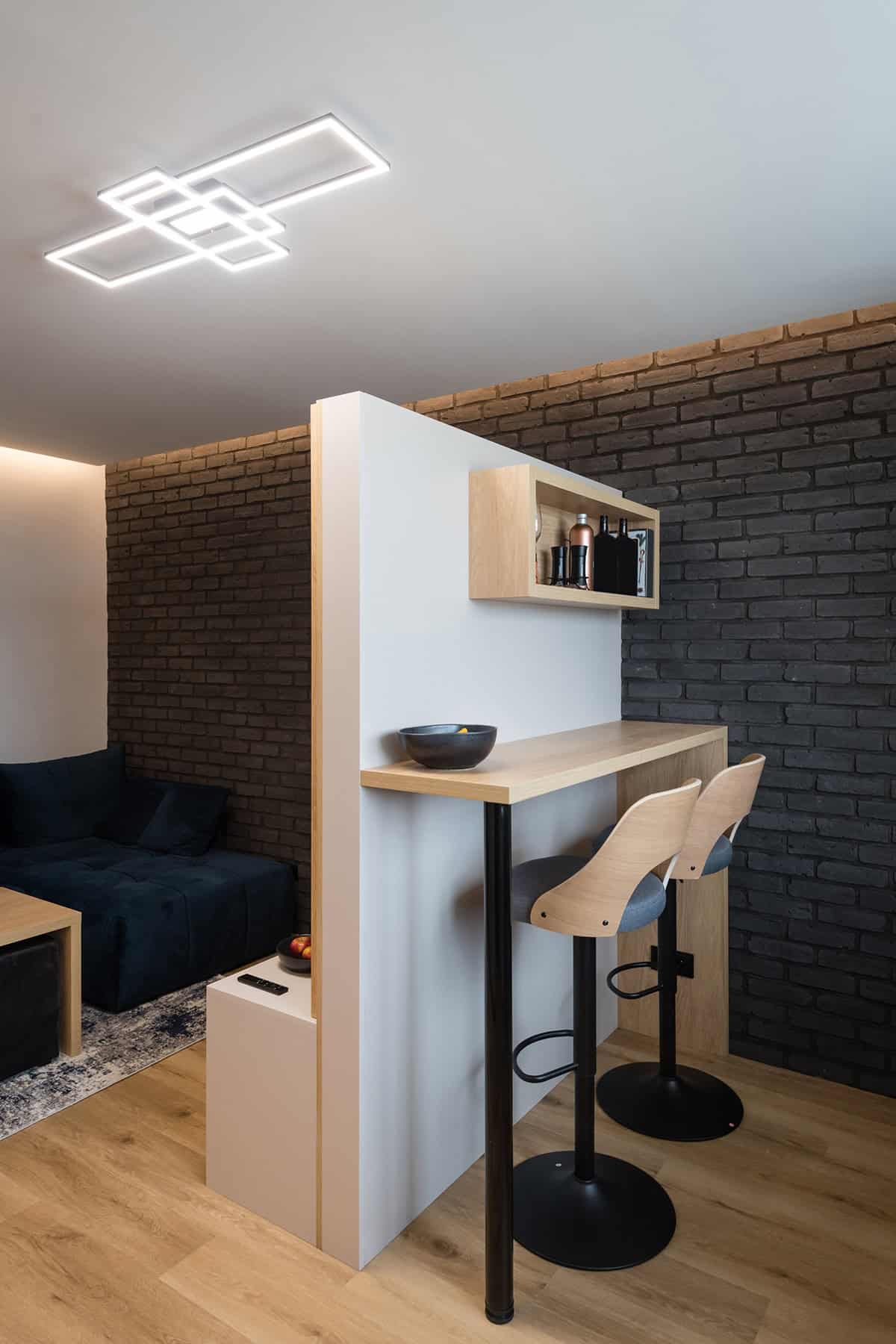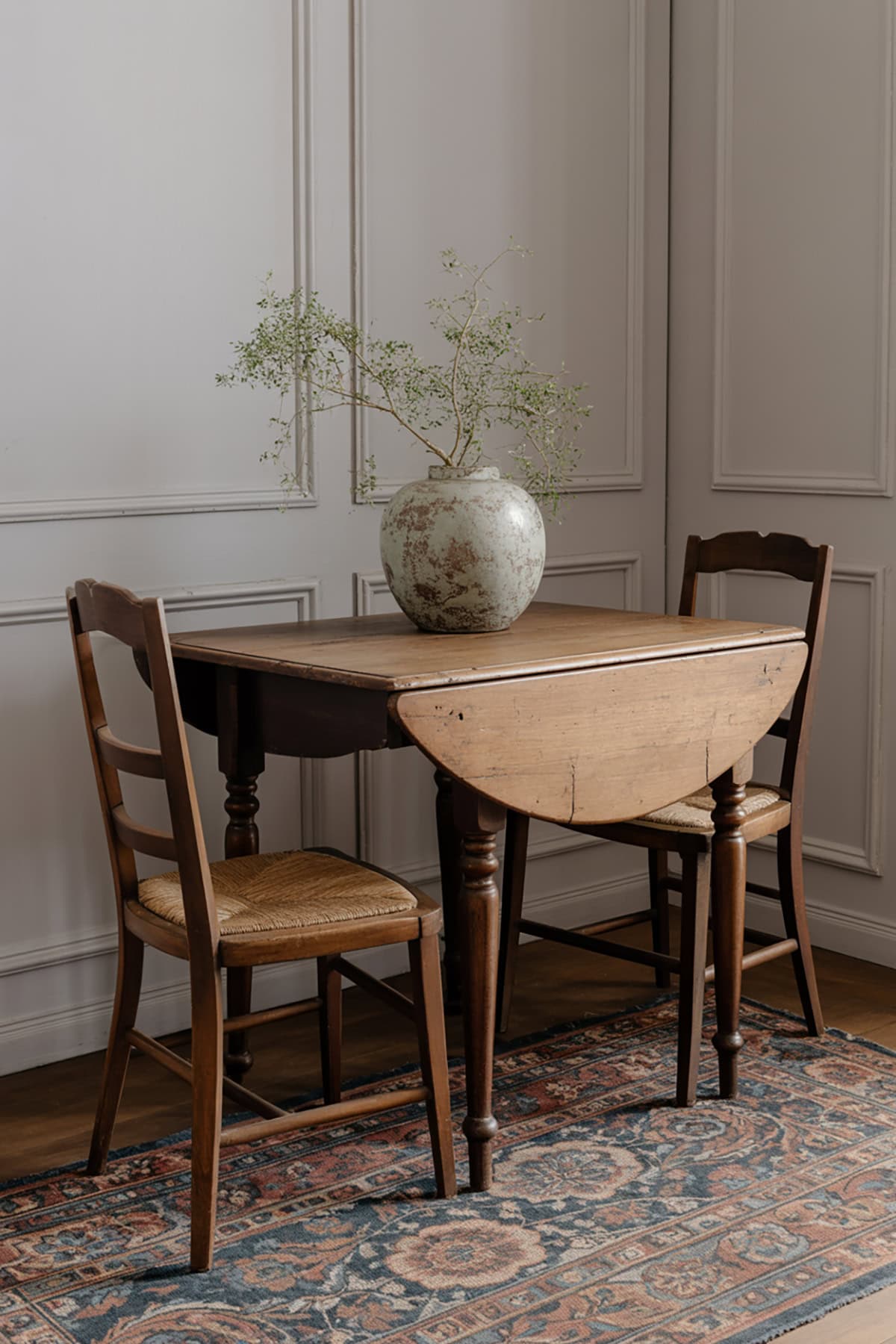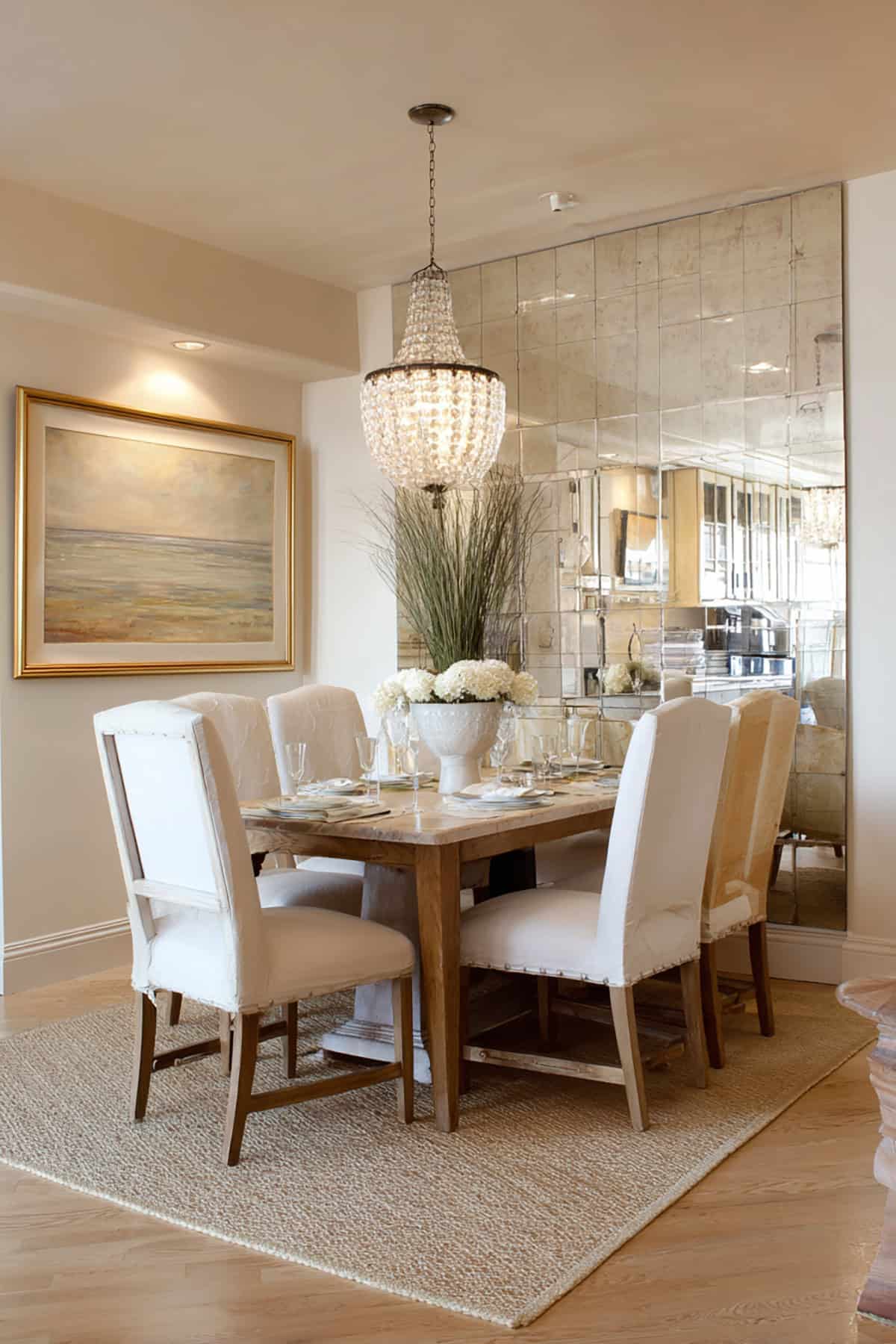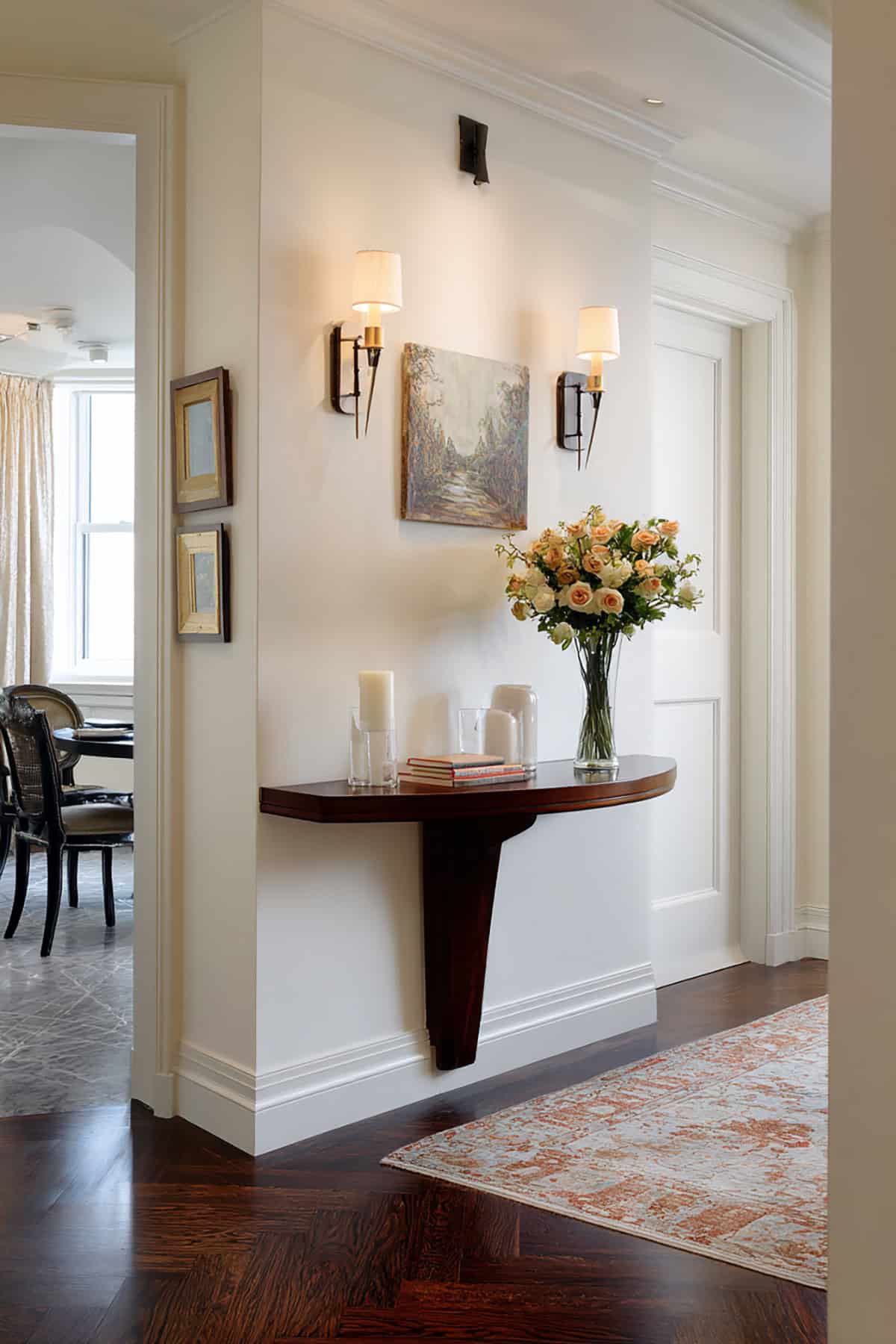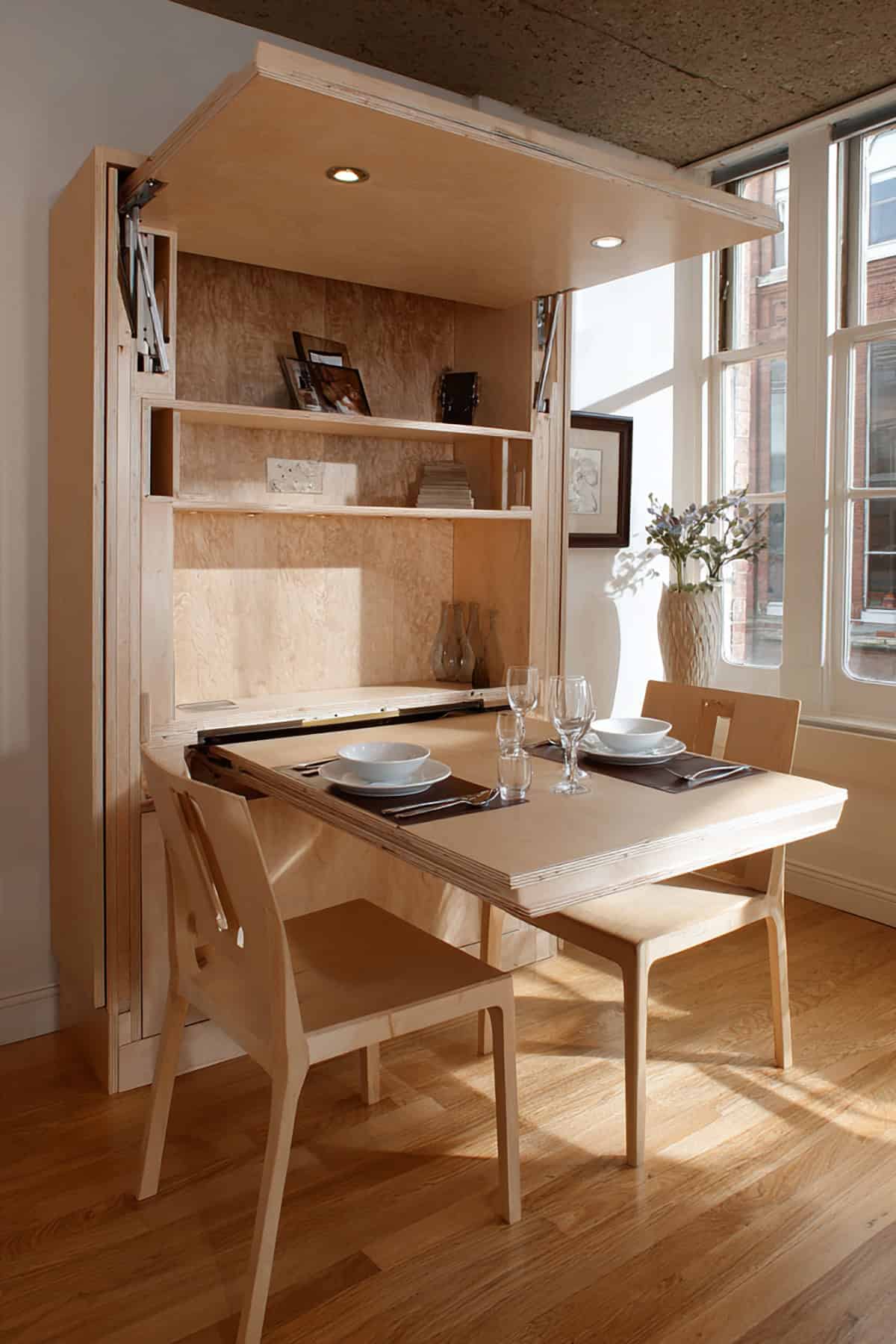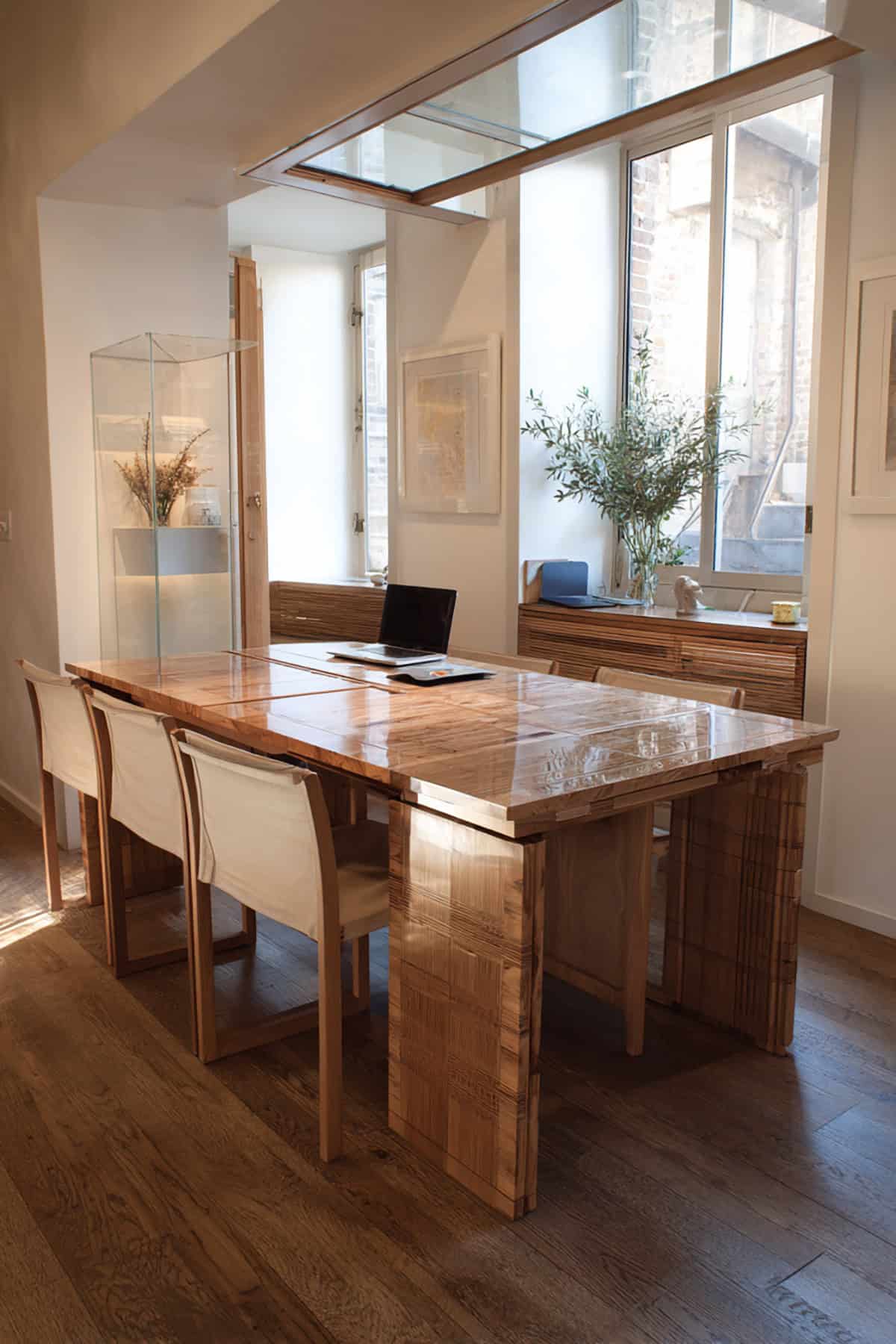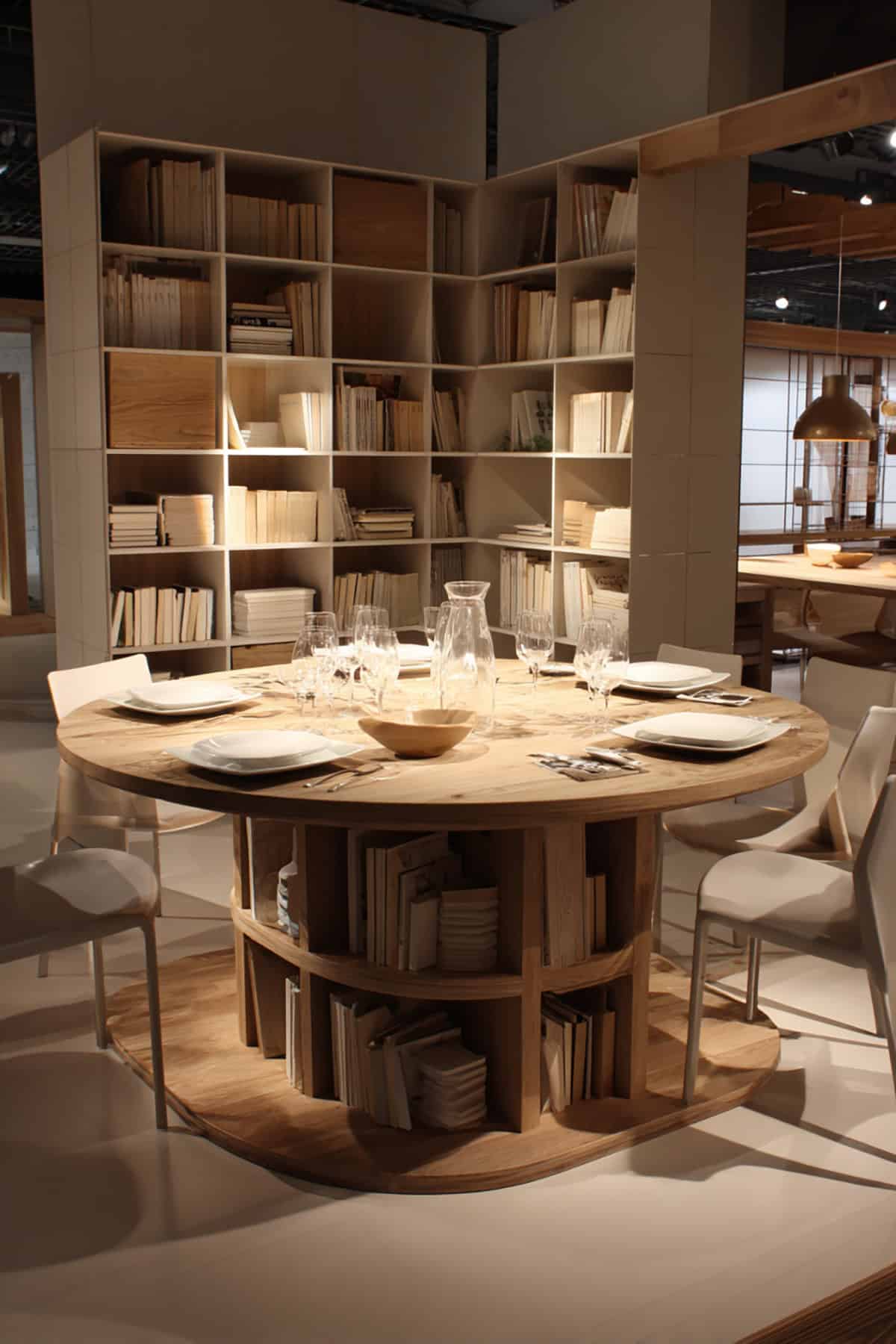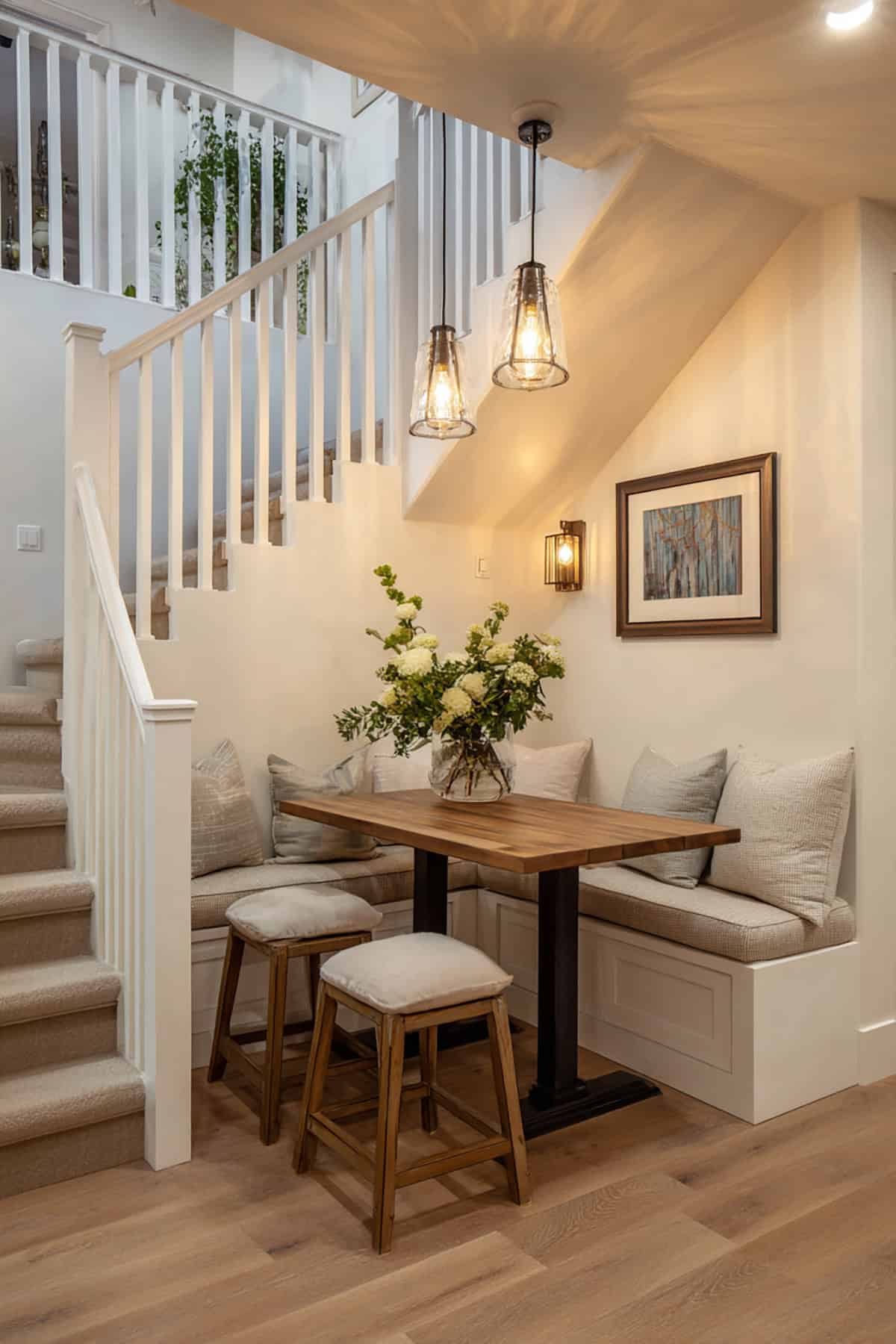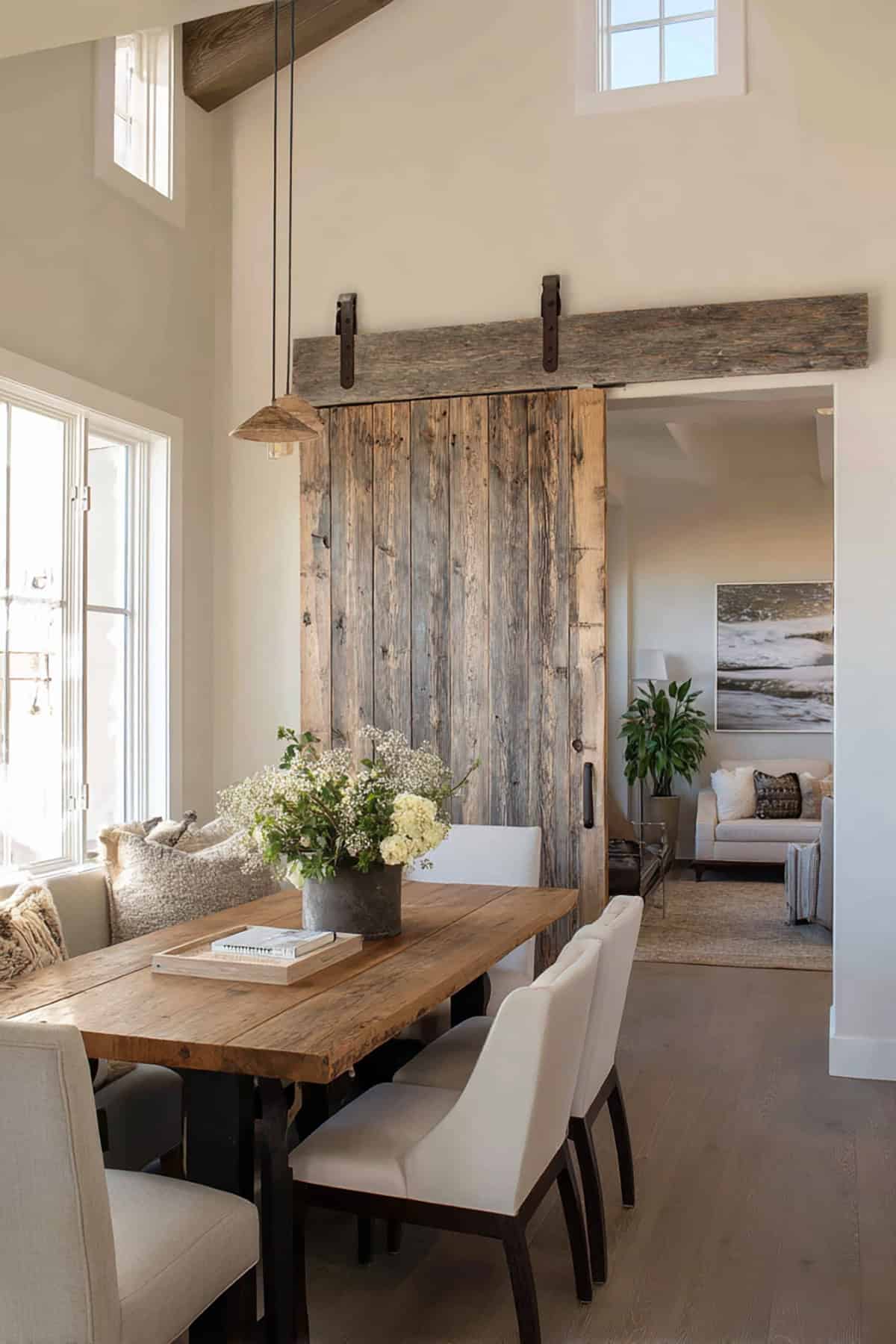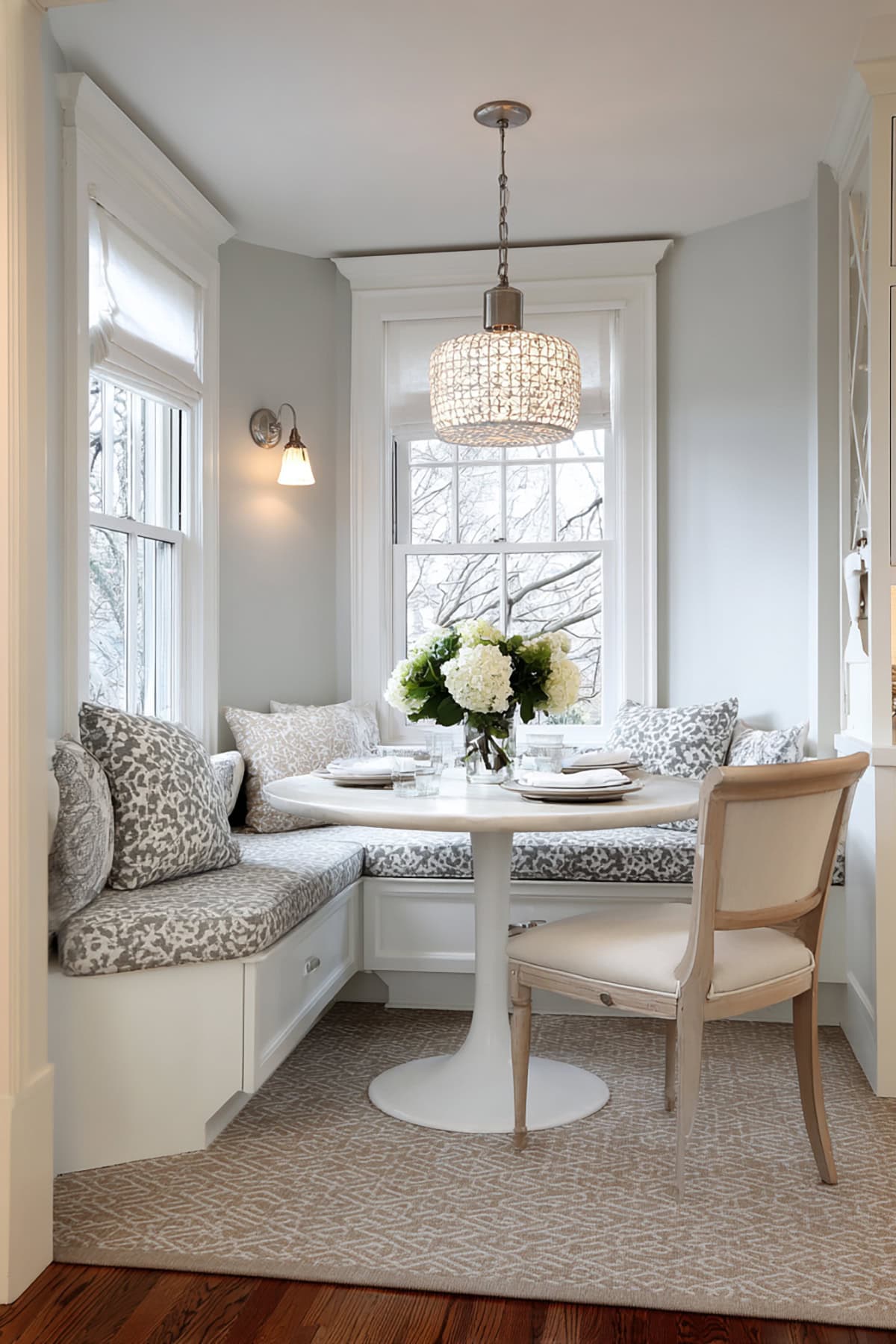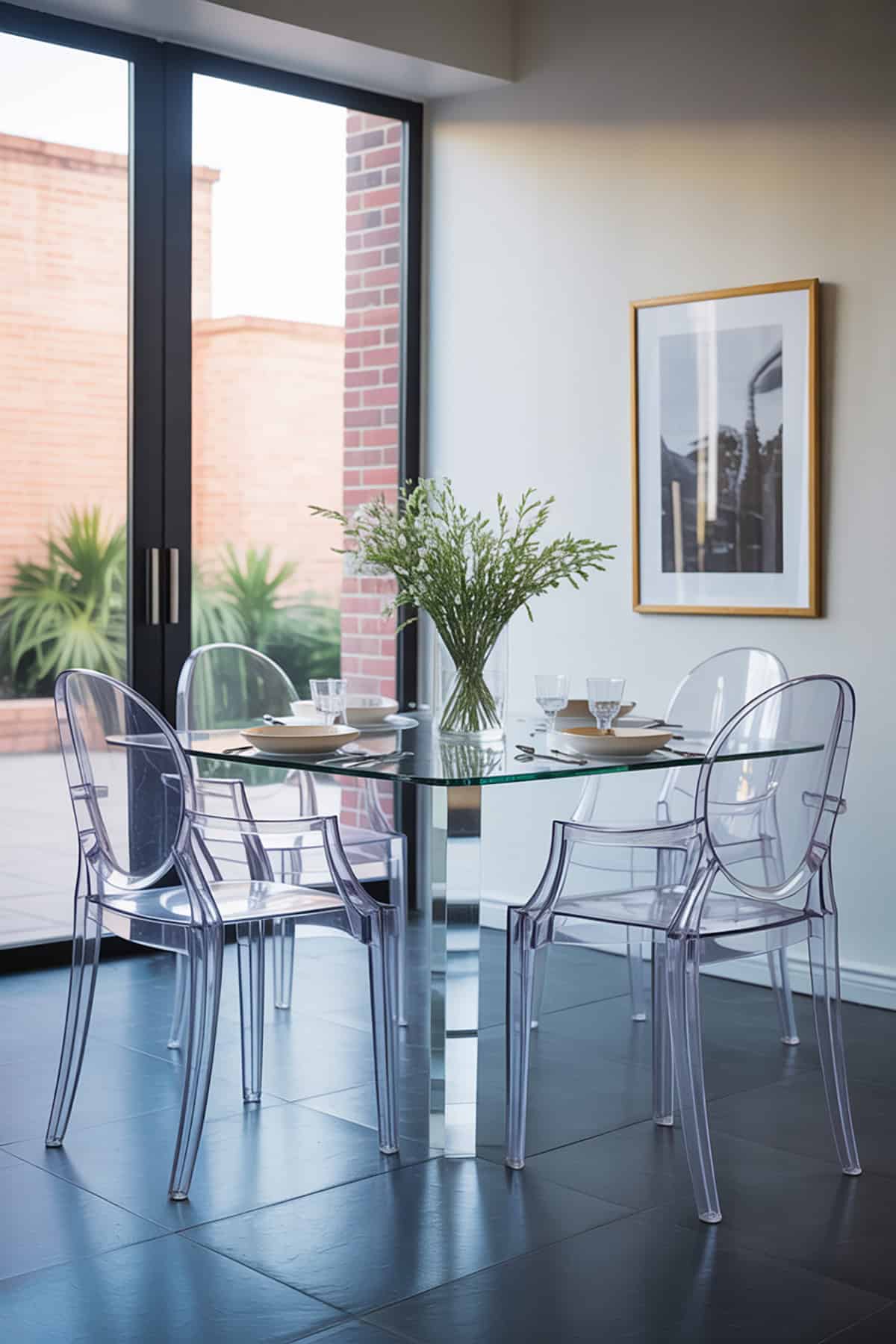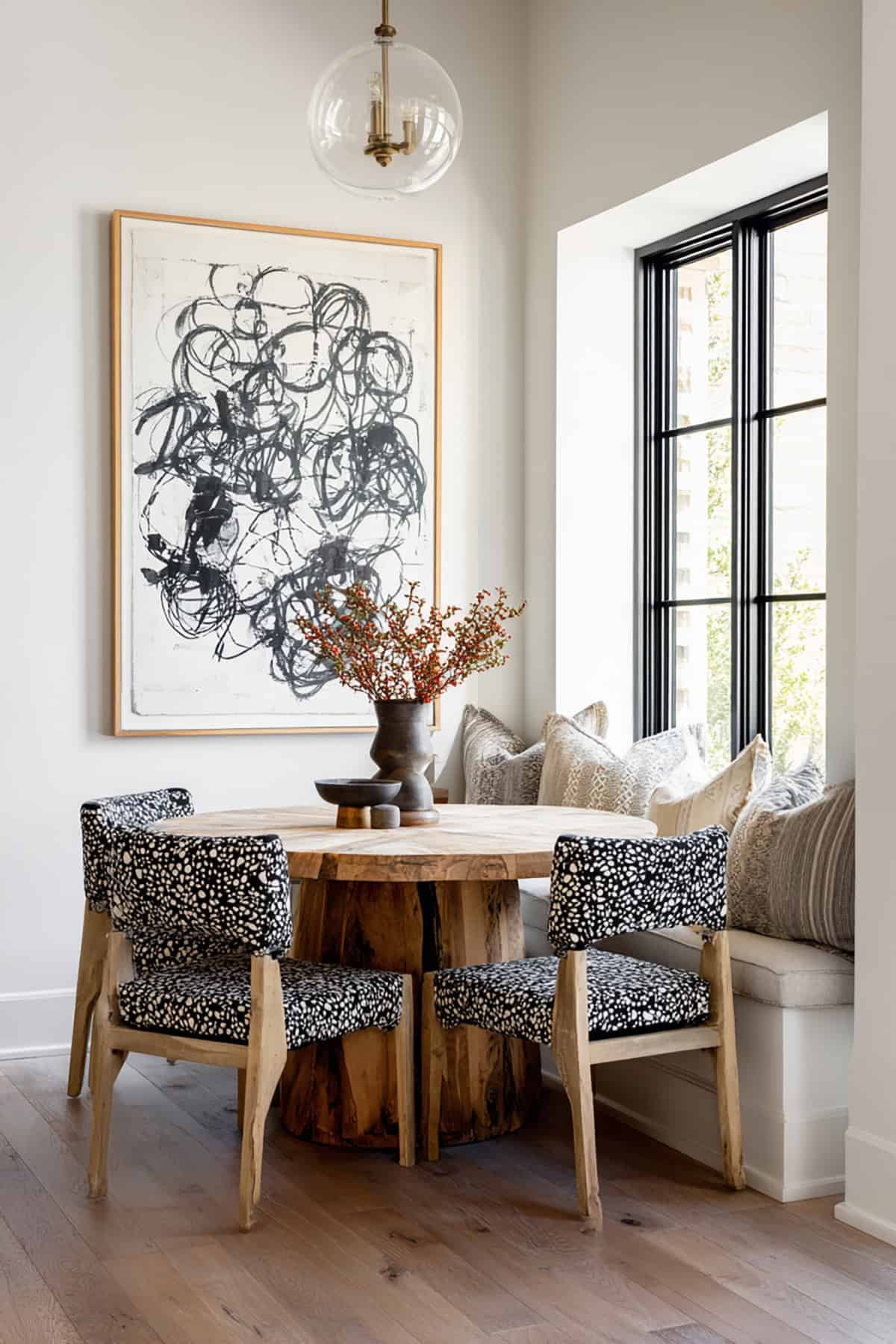Designing a dining room goes beyond just choosing tables and chairs. Whether you’re hosting family dinners or catching up with long-lost friends, you need to create a space that brings people together. This is easier said than done, especially in small dining rooms. However, the right layout and colors can turn the most mundane space into a welcoming part of your home.
Table of Contents
- 41 Small Dining Room Ideas
- Round Tables to Improve Flow
- Drop-Leaf Table for Flexibility
- Banquette Seating Along the Wall
- Slim, Armless Chairs
- Lightweight Furniture You Can Move Easily
- Console Table as a Dining Table When Needed
- White or Neutral Walls
- Light Color Ceiling to Add Height
- Avoid Dark or Heavy Colors
- Wall Sconce to Free Floor/Table Space
- Large Mirror to Visually Double the Room
- Floating Shelves for Display and Storage
- Hutch Room Divider
- Sideboard for Added Storage
- Vertical Storage to Maximize Wall Space
- Minimal Decor to Avoid Overwhelm
- Natural Elements Like Wood and Plants
- Sheer Curtains to Let Light In
- Rug-Free
- Table Runners Instead of Full Tablecloths
- Dining Booth
- Kitchen Island as a Dining Table
- Soft Modernity with a Warm Palette
- A Pop of Blue to Lift the Mood
- Colorful Urban Sophistication
- Blue Cottage Charm Meets Rustic Brick
- Green Mosaic with a Cozy Corner Setup
- Industrial Touch with Minimalist Style
- Vintage Drop-Leaf Table with Character
- Two-Seater Bistro Setup by a Window
- Mirror Wall Behind Dining Table
- Half-Round Wall Table for Hallway Dining
- Fold-Out Dining Table from Cabinet
- Floating Table Attached to Wall
- Extendable Table in a Dual-Use Room
- Dining Table with Integrated Bookshelf Base
- Dining Nook Under the Stairs
- Dining Area with Sliding Barn Door Divider
- Corner Banquette with Built-In Storage
- Clear Acrylic Chairs and Dining Table
- Art-Led Focal Point in the Dining Nook
41 Small Dining Room Ideas
Small dining rooms can feel vast and stylish with the right planning. Here, you’ll find 41 inspiring ideas to help you remodel your small dining room with confidence.
Round Tables to Improve Flow
Credit to decor_by_mira
In small areas, the goal is to improve flow and movement. For small dining rooms, this is achievable with the help of round tables. Their shape eliminates harsh corners while also maximizing seating capacity. Best of all, conversations keep flowing since everyone is looking at each other equally. Consider picking up a glass-topped version to enhance the feeling of spaciousness.
Drop-Leaf Table for Flexibility
Credit to surethings__
If you really want to go a step beyond, then a drop-leaf table is you best bet. These are game-changers that offer balance of form and function. Simply lift and set a leaf in place to extend your dining area, or fold them down when you have fewer guests over. Its adaptability allows you to free up more floor space when the need arises. Move the table up against the wall to transform it into a console or desk when not in use.
Banquette Seating Along the Wall
Credit to scoutandnimble
Banquette seating is for more than just buffets. Their charm comes in handy in small dining rooms since they take up wall space. Banquette seating recreates the coziness of a diner, but they also have a practical function: their benches can open from the top to become storage space. Add throw pillows on top of the cushioned benches for added style points.
Slim, Armless Chairs
Credit to shophouseofnomaddesign
A big part of designing the layout of a small area, including small dining rooms, is creating the illusion of space. Slim, armless chairs help with this effect. They also help by taking up less space, so you can fit more seats around your dining table. You can maintain the stylishly slim look by choosing chairs with lower backs and sleek legs. Metal and clear acrylic are winners when it comes to compact spaces and durability.
Lightweight Furniture You Can Move Easily
Credit to simpleelegancedesign_co
While we’re on the subject of seating, we should also focus on how heavy your furniture is. Lightweight furniture adapts to different needs effortlessly, whether you’re entertaining guests, cleaning the floor, or making space for another activity—e.g., studying. Aluminum and molded plastic are simple and lightweight, but you should aim for a balance between aesthetics and comfort.
Console Table as a Dining Table When Needed
Credit to magenhgallery
Most people think that console tables are reserved for entryways and living rooms. This simply isn’t the case. They can be incredibly versatile and belong to any room. For instance, you can turn a simple console table into a dining table, which is an excellent space-saving solution for small dining rooms. When not dining, push the table against the wall to resume its console-table duties.
White or Neutral Walls
Credit to interiordesignnepal
The color of your dining room can be just as important as its layout. Light, neutral wall colors open up a small dining room by reflecting natural sunlight. White, beige, or pale gray help create the illusion of vastness in tight areas. Additionally, neutral colors are versatile backdrops and accents in the form of layered artwork or table settings. Maintain a subtle palette to keep your small dining room looking fresh and clean.
Light Color Ceiling to Add Height
Credit to thorvald.design
Shift your gaze upward and look at your ceiling. A light-colored paint can trick the eye into believing there’s more vertical space than there actually is. Soft whites or pale blues brighten the dining room while visually increasing the height of your ceiling. You can further enhance the effect by pairing a bright ceiling with matching crown molding.
Avoid Dark or Heavy Colors
Credit to robertsprojectsanddesign
Remember that light can make a room feel airier and bigger than it is. Dark colors, however, absorb light, which tends to make a dining room feel cramped. While dark colors like black and brown can add a dramatic effect in larger rooms, they become overpowering in tight spaces. Instead of covering entire walls in dark paint, use it sparingly in accents—artwork, cushions, other accessories.
Wall Sconce to Free Floor/Table Space
Credit to _stylishmama_
Wall sconces provide ambient lighting. They can also focus their lights on specific objects to highlight statement pieces in your dining room. The best thing about wall sconces is that they don’t take any table or floor space. As they’re mounted on walls, you can clear your tables for other essential items. If you really want to go the extra mile, choose sconces with adjustable dimming features to set the mood.
Large Mirror to Visually Double the Room
Credit to rooma_sg
While bright walls can reflect light, they are unmatched against mirrors. Place a large mirror against a wall, preferably at a slight angle in front of a window. The mirror bounces sunlight around the room, which helps keep your guests’ eyes drawn upward. This simple trick requires little to no floor space. Choose a mirror with a stylish frame and let it serve as a decorative yet practical dining room fixture.
Floating Shelves for Display and Storage
Credit to downsouthfurnishings
Floating shelves are a modern way to increase storage space in any room. In a small dining room, you can mount floating shelves high on the wall to free up floor space. They create a spot to place dishes, plants, or other decorative pieces. Give your small dining room corner’s a new meaning in life by adding corner shelves, or place the shelves directly above a banquette or booth.
Hutch Room Divider
Credit to durasupreme
In open-plan layouts, you need to figure out a way to separate your dining room and adjacent spaces. A hutch can help with this task by becoming a place for storing plates and dishes, as well as becoming a partition between rooms. Double-duty hutch room dividers anchor the dining room setup while also maintaining an open flow.
Sideboard for Added Storage
Credit to sundaysfurniture
A sideboard is a versatile piece of furniture most commonly found in dining rooms. They provide storage space for keeping dinnerware and linens out of view and dust-free. It is a compact piece with a low-profile top that can also serve as a self-serving spot for dishes. Ideally, the sideboard will have a sliding door to reduce space usage.
Vertical Storage to Maximize Wall Space
Credit to summer.wick
There are several ways to maximize vertical space. We talked about floating shelves earlier and hutches earlier, but other options include tall shelving units and pegboards. Vertical storage keeps your guests’ eyes drawn upward to make the ceiling appear higher, thus making the room feel airier. This is especially effective in narrow dining rooms where conventional furniture pieces take too much room.
Minimal Decor to Avoid Overwhelm
Credit to inspirationalhomedecoration
Less is more in small dining rooms. Too many decorative pieces tend to make the area feel cramped and chaotic. What you should do is focus on a few well-chosen pieces and accents that add personality without overwhelming the room. Use a minimalistic approach to highlight the most important factors—i.e., comfort, ample seating, and a welcoming dining area.
Natural Elements Like Wood and Plants
Credit to sanabriaandco
Natural elements, such as wood and plants, can warm up a small dining room. The ultimate goal is to make it feel more welcoming. Wood tones and patterns, in the form of furniture and shelving, give texture and organic beauty. However, if you really want organic beauty in the dining room, you can’t go wrong with a few well-placed plants. Go compact with succulents or make a statement with large hanging plants.
Sheer Curtains to Let Light In
Credit to perthwindowdecor
Sheer curtains are see-through curtains that provide a bit of privacy while also allowing natural sunlight to filter in. Heavy drapes, on the other hand, tend to block out light and make a room feel more cramped, which is the opposite of what we’re trying to achieve in a small dining room. Choose light, airy fabrics like voile or linen. Stick to natural tones to fit the atmosphere of the room and décor.
Rug-Free
Credit to hanantehaili
While area rugs can help define a space in an open-layout area, they tend to make rooms feel smaller than they are. Skipping the rug reduces visual clutter, thereby making the small dining room feel vast. Another benefit of avoiding area rugs is reduced after-meal cleanup. No need to whip out the carpet cleaner when there are no shaggy areas to soil. If you prefer a bit of texture beneath your feet, choose low-profile mats that complement the visual openness of your dining room.
Table Runners Instead of Full Tablecloths
Credit to julieinspo73
When it comes to protecting your dining table from spills, there are two options: tablecloths and table runners. The former provides more protection but can add the feeling of unnecessary bulk on your table. On the hand, table runners provide texture, color, and an uncluttered look to tables of any shape and size. They’re also easier to clean and replace if you have different runners for different times of the year.
Dining Booth
Credit to zoefeldmandesign
If you have a tight spot in your small dining room—perhaps the area is sandwiched between partitions or tall cabinets—a dining booth might be the answer to your problems! Dining booths make excellent use of limited wall space with its built-in seating, storage, and cohesive look. They provide café-like vibes that encourage longer chats during meals. However, they are usually set in place, so moving the seats and table around is out of the question.
Kitchen Island as a Dining Table
Credit to amberinteriors
When space is limited, you can turn a kitchen island into a multipurpose fixture. It serves not just as a place for fruits and appliances, but it can also double as a dining table in open-concept layouts. A few stools or slim chairs are all it takes to create a dining area for your guests.
Soft Modernity with a Warm Palette
There’s something comforting about a space that doesn’t try too hard. A neutral color scheme, soft textures, and clean furniture lines keep things grounded here. The condo layout includes a small glass dining table tucked between the kitchen and seating area, with everything styled for efficiency and calm. It feels tailored but never uptight.
A Pop of Blue to Lift the Mood
Not every small room needs to lean into white walls. A vibrant blue accent can energize the entire setup, even if the space barely fits a table and two chairs. This layout pairs that bold color with a clean white kitchen and pale wood floors. The little green vase and cheerful blue teapot add charm without clutter.
Colorful Urban Sophistication
Small condo living doesn’t have to mean minimal color. This space makes a statement with rich teal walls and bold patterned furniture, without sacrificing function. The open-plan layout allows the kitchen, dining, and lounge to flow together, anchored by coordinating tones. It’s lively, yet cohesive—and a little glam without being flashy.
Blue Cottage Charm Meets Rustic Brick
Some small spaces channel personality better than large ones. This condo brings in country cottage warmth with powder blue cabinetry and an exposed brick hood that feels straight from a cozy countryside kitchen. Natural light filters in through wide windows, casting soft shadows over the dining table and wooden chairs.
Green Mosaic with a Cozy Corner Setup
In tight layouts, it helps to pick one surface or feature to make a quiet statement. The green tile backsplash here offers a refreshing break from neutrals and makes the space feel intentional. A small wooden table sits near the window with just enough space for a casual breakfast setup. Everything fits, and nothing feels forced.
Industrial Touch with Minimalist Style
Some condos embrace their structural bones—and it works. Here, exposed brick and bar-height seating set the tone, with clean lines and minimal furniture filling in the rest. A compact table serves double duty as a workspace and dining zone. It’s the kind of setup that feels functional without losing edge or style.
Vintage Drop-Leaf Table with Character
Some pieces do more than save space—they add soul. This drop-leaf table works double duty as a compact dining spot and an old-world design element. Paired with spindle-back chairs and wood tones that feel warm and worn in the best way, it fits right into a cozy condo setting without taking over.
Two-Seater Bistro Setup by a Window
Nothing beats a corner with a view, especially when space is tight. This small bistro setup makes great use of a window nook, perfect for breakfast or a quiet evening drink. Slim black legs and a round tabletop keep the look simple, while potted plants and soft curtains make it feel lived-in.
Mirror Wall Behind Dining Table
In small living spaces, light and reflection are your best friends. This setup takes advantage of both with a floor-to-ceiling mirror behind the dining table, creating depth without adding any actual square footage. The wood dining set and subtle light fixture keep things grounded and warm.
Half-Round Wall Table for Hallway Dining
Hallways don’t usually double as dining zones, but here it works beautifully. A half-round table hugs the wall to save space, while the setup still feels intentional and cozy. The cushioned bench makes it comfortable, and pendant lighting ensures it feels like a real destination in the home.
Fold-Out Dining Table from Cabinet
Storage doesn’t always have to hide away—sometimes it becomes the main feature. This clever fold-out table tucks seamlessly into a cabinet when not in use, making it ideal for studio condos or homes that need every inch to multitask. It’s functional, but it also looks sharp when open.
Floating Table Attached to Wall
When floor space is at a premium, the wall becomes your best design tool. This floating table attaches directly to the wall with no legs in sight, making the area feel more open than it actually is. It’s paired with modern chairs and a minimal color scheme to keep things fresh.
Extendable Table in a Dual-Use Room
Rooms in condos often serve more than one purpose, so flexibility is key. This extendable table transitions easily from a two-person layout to something that hosts four—without losing its sleek shape. The muted tones and streamlined chairs keep the space cohesive, whether it’s used for work, meals, or both.
Dining Table with Integrated Bookshelf Base
Why not make the most of every surface? This dining table pulls double duty with a built-in bookshelf as its base, adding storage and charm in one shot. The open shelving is perfect for showing off cookbooks or adding a little personality to a tight corner.
Dining Nook Under the Stairs
Condos with staircases sometimes leave awkward pockets of space—but this one found the sweet spot. A small table and two chairs turn the under-stair area into a legit dining nook. With artwork above and a soft rug underfoot, it becomes a cozy corner that feels both tucked away and inviting.
Dining Area with Sliding Barn Door Divider
Open-concept living has its perks, but sometimes you want zones. This setup uses a sliding barn door to visually separate the dining area without closing anything off completely. It adds just enough definition while keeping the space airy and connected to the rest of the room.
Corner Banquette with Built-In Storage
You don’t always need extra square footage to gain more seating and hidden storage. A corner banquette like this one transforms an awkward nook into a charming breakfast zone that works just as well for dinner parties. The drawer base quietly tucks away placemats, linens, or anything you’d rather keep out of sight.
Clear Acrylic Chairs and Dining Table
If your dining area shares space with your living zone, keeping things visually light can make a huge difference. Clear acrylic chairs and a glass-top table help this modern condo dining corner feel open, breezy, and clutter-free. Even in a tight layout, nothing here feels cramped or boxed in.
Art-Led Focal Point in the Dining Nook
A strong visual anchor can pull a small dining space together and give it real character. Here, the oversized black-and-white art piece balances beautifully with the chunky wood table and soft bench seating. This combo adds warmth, personality, and just enough drama without taking up more physical space.
